2020 has been like a giant magnifying glass for our country, our cities, and ourselves. The devastating impact of the COVID-19 pandemic forced us to reevaluate our priorities and examine what it is about travel that makes us all love it so much — and miss it when that privilege is taken away from us. It’s not the perks of an airport lounge or the Instagram likes you get on a vacation selfie. It’s the people and the places where we can connect with each other — be it with our travel companions or complete strangers.
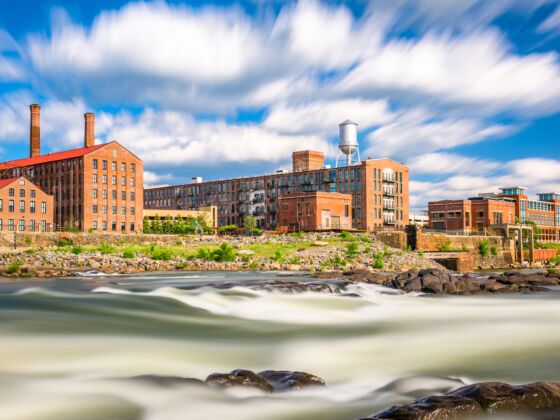

The 25 Coolest Towns in America to Visit in 2021
In most places around the United States, 2020 saw the closure — temporary or otherwise — of those places where we connect: bars, restaurants, festival grounds, bookshops, museums, and other institutions that give a destination its character in the first place. Trying to highlight the “cool” in a decidedly “uncool” year might sound like a fruitless effort, but towns across the country have defied overwhelming odds to prove their resilience.
When we peek through the magnifying glass, it’s that resilience that looms largest. From cash-strapped communities scraping together donations to save a local bookstore to the creative reimagining of outdoor spaces to keep restaurants afloat, our towns are refusing to let a pandemic diminish their character. And that’s pretty cool.
2020 was the year we fell in love with domestic travel again, and we’re carrying that passion for safely exploring our own backyard into the new year. In no particular order, these are the 25 coolest towns in America that you should visit in 2021.
Editor’s note: Not every restaurant, bar, museum, or performance venue listed is currently open, nor is every event confirmed for 2021. We are writing optimistically in hope that these beloved institutions will be operational eventually in the new year. Please check local restrictions and safety protocols before planning a trip, and remember to mask up. Population counts are approximate and based on recent census data.
1. Biddeford, Maine
Population: 21,574
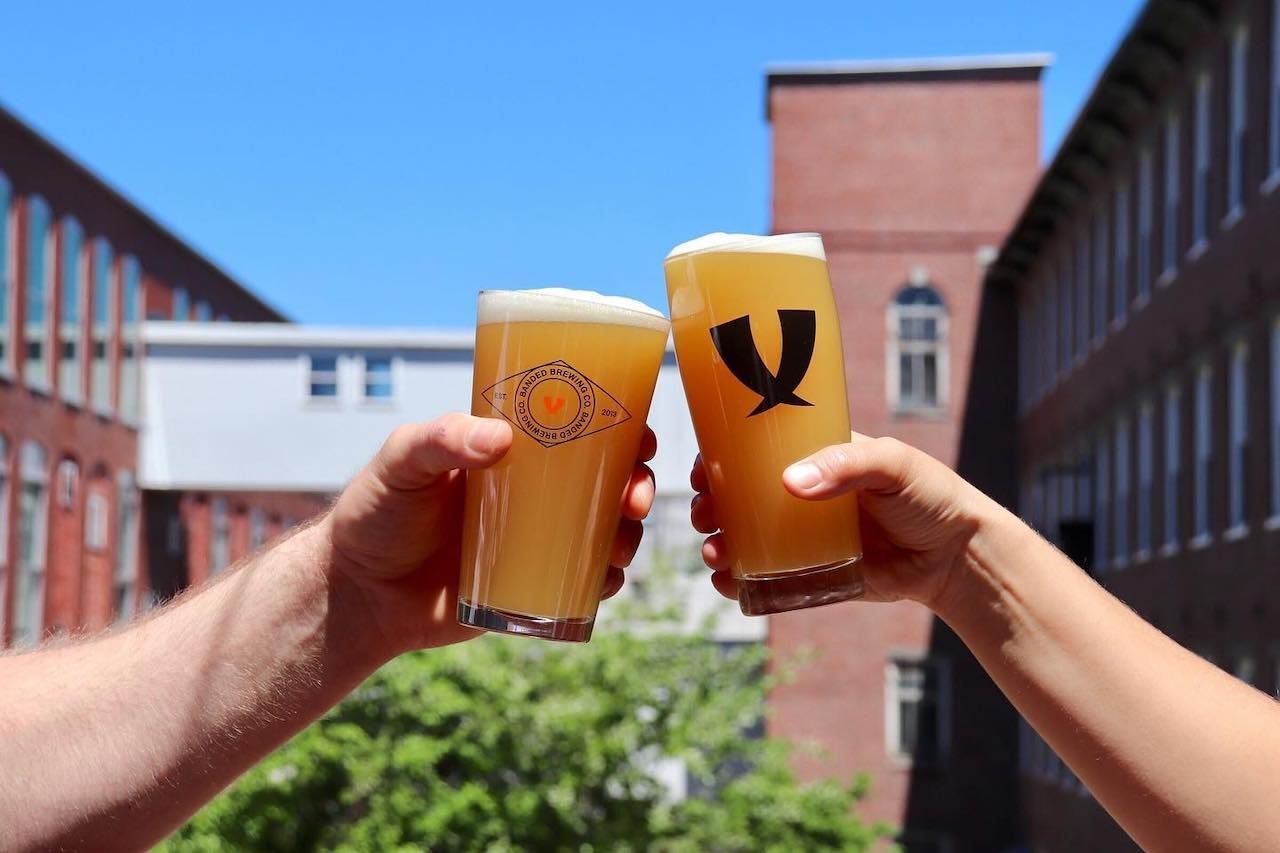
Photo: Banded Brewing Co./Facebook
When travelers head up the coast of Maine, it can be tempting to settle for the scenic one-two punch of Ogunquit and Kennebunkport. While you can’t go wrong with any of Maine’s seaside towns, Biddeford is a little different. Just 20 minutes north of Kennebunkport and right on the Saco River, Biddeford was once a thriving mill town and home to the largest cotton mill in the country. Now those mill buildings have been creatively repurposed to house businesses, and the city’s industrial roots blend seamlessly with its natural areas and a buzzing craft beer culture.
Biddeford is close to some of Maine’s most tantalizing outdoor spaces. The Rachel Carson National Wildlife Refuge stretches for 50 miles along the coast, preserving marsh and estuary areas that serve as a habitat for migrating birds. Trails make the refuge easily walkable, and you shouldn’t be surprised if a few deer cross your path. Then head to Fortunes Rocks Beach where you can surf, bodyboard, kayak, or climb on the rocks.
If you go to Maine without stopping at a brewery, did you really go to Maine? Banded Horn Brewing Co, located in an old mill building, is one of the most popular in the entire region, with no shortage of in-house beers on tap. If spirits are more your style, there’s also a distillery located in a 150-year-old textile mill called Round Turn. It even uses the steam created from the Saco River to power the still.
Nowhere encapsulates the coastal Maine experience better than the Hidden Pond Resort, with cottages and bungalows on 60 acres of birch forest between Biddeford and Kennebunkport. Just 15 minutes from downtown Biddeford, and under five minutes from Goose Rocks Beach, it’s the perfect blend of beach and classic Maine wilderness.
2. Ocean Springs, Mississippi
Population: 17,809
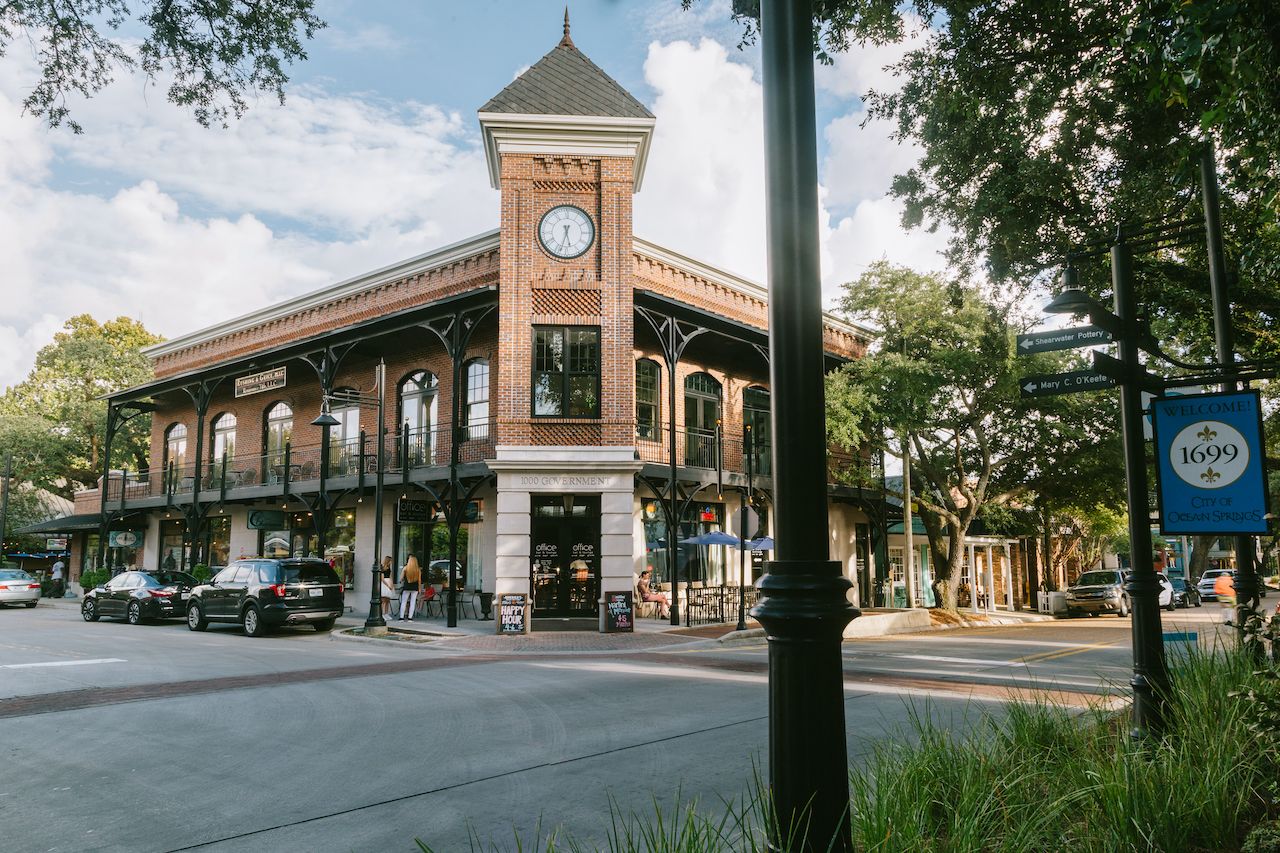
Photo: Coastal Mississippi
You’ll hear something along the lines of, “We’re not like the rest of Mississippi,” oft-repeated by locals throughout Ocean Springs. We’re not sure what that means, exactly, but that claim of differentiation from whatever our collective idea of Mississippi is seems to be the rallying cry of everyone in this little beach town.
Ocean Springs sits just across the bridge from the mega-casinos of Biloxi and is the essence of a Southern weekend getaway, with a heavy dose of art thrown in. The longtime home of renowned artist Walter Anderson has drawn a community of artists that make the place feel more like Napa than Natchez. There’s an entire museum devoted to Anderson, yes, but the streetside musicians, downtown galleries, and immaculate attention to decoration are what make Ocean Springs so special.
Live music is the heart of Ocean Springs after dark. Taking a stroll down Government Street, you’ll hear everything from blues to rock to folk music accompanying your walk. Spots like The Juke Joint, Government Street Grocery, and Mosaic give you a glimpse into the local music scene — and you can walk from bar to bar with a drink here, which never hurts.
You’ll find the attention to artisanship everywhere in Ocean Springs, whether it’s at the individually designed suites at the Roost Hotel or in the croissant case at French Kiss Pastries, which smells like a Paris morning on a main street draped in Spanish moss. You’ll find it at Vestige, too, where James Beard-nominated chef Alex Perry uses local ingredients to create Japanese-inspired specialties.
Whether Ocean Springs is like the rest of Mississippi really depends on what you think the rest of the state is like. But if you imagine it as a warm, lush place with friendly people and great music, then Ocean Springs is about as Mississippi as it gets.
3. Fairfield, Iowa
Population: 10,216
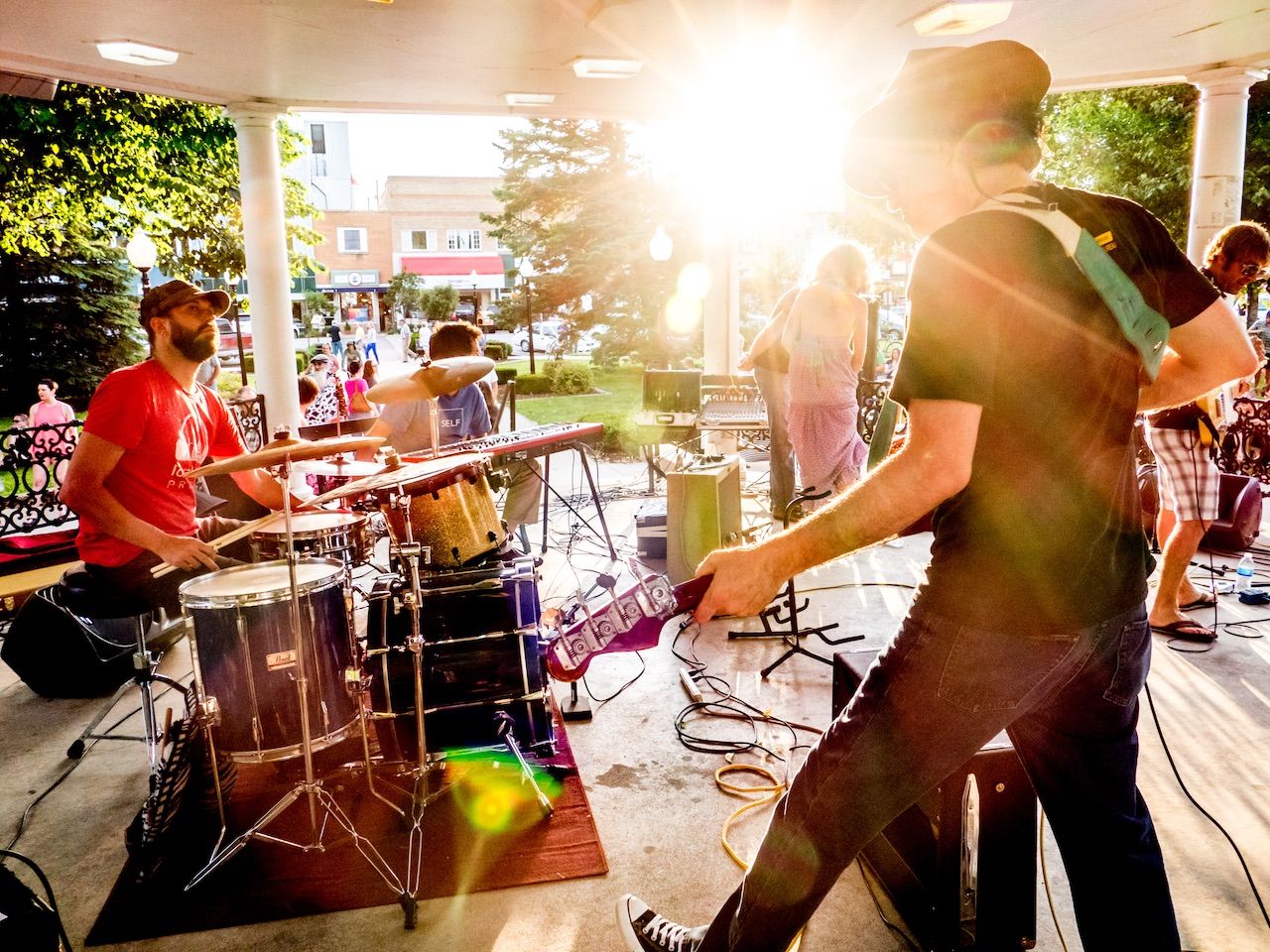
Photo: Paul Delisle / Fairfield Convention and Visitors Bureau
Half Sedona vibes, half Asheville vibes, Fairfield, Iowa, is a hard-to-describe kind of place. For starters, out of cornfields and swaths of soybeans pops up the world’s largest training center for the Transcendental Meditation technique. Start-ups and small tech companies dot the 10,000-person town. The first Carnegie library outside of Pennsylvania stands two blocks from a vegetarian restaurant and a synagogue. You cannot categorize the Midwest, hard as the powers that be may try, and you certainly cannot categorize Fairfield.
The Maharishi International University — which explains the whole meditation bit — started drawing eclectic crowds here in the ‘70s; they traded Santa Barbara, California, for somewhere out of the way, even by Iowans’ standards, and the town’s eclectic fate was sealed. The crowds they drew, though, became the permanent kind; tourism isn’t a huge driver here, as showcased by the hotel offerings. That is, you may find yourself setting up shop at the Quality Inn. For now, at least. At this rate (it’s one of the fastest-growing spots in the state), the boutique hotels and retro lodges will come.
Don’t let that set your expectations, though. Today you have a bustling village that drools over both Casey’s pizza and Istanbul Grill; that designs its storefronts for sustainability (here’s to you, Chickadee); that grew a tech scene called “Silicorn Valley”; that alights with funky coffeehouses, art galleries, and cideries (cheers to Jefferson County Ciderworks); and that throws one hell of a First Friday. Realistically, there is not a quintessential Fairfield experience — the thing to do here is simply to shatter your own presuppositions. And then meditate on it.
4. Yakima, Washington
Population: 93,884
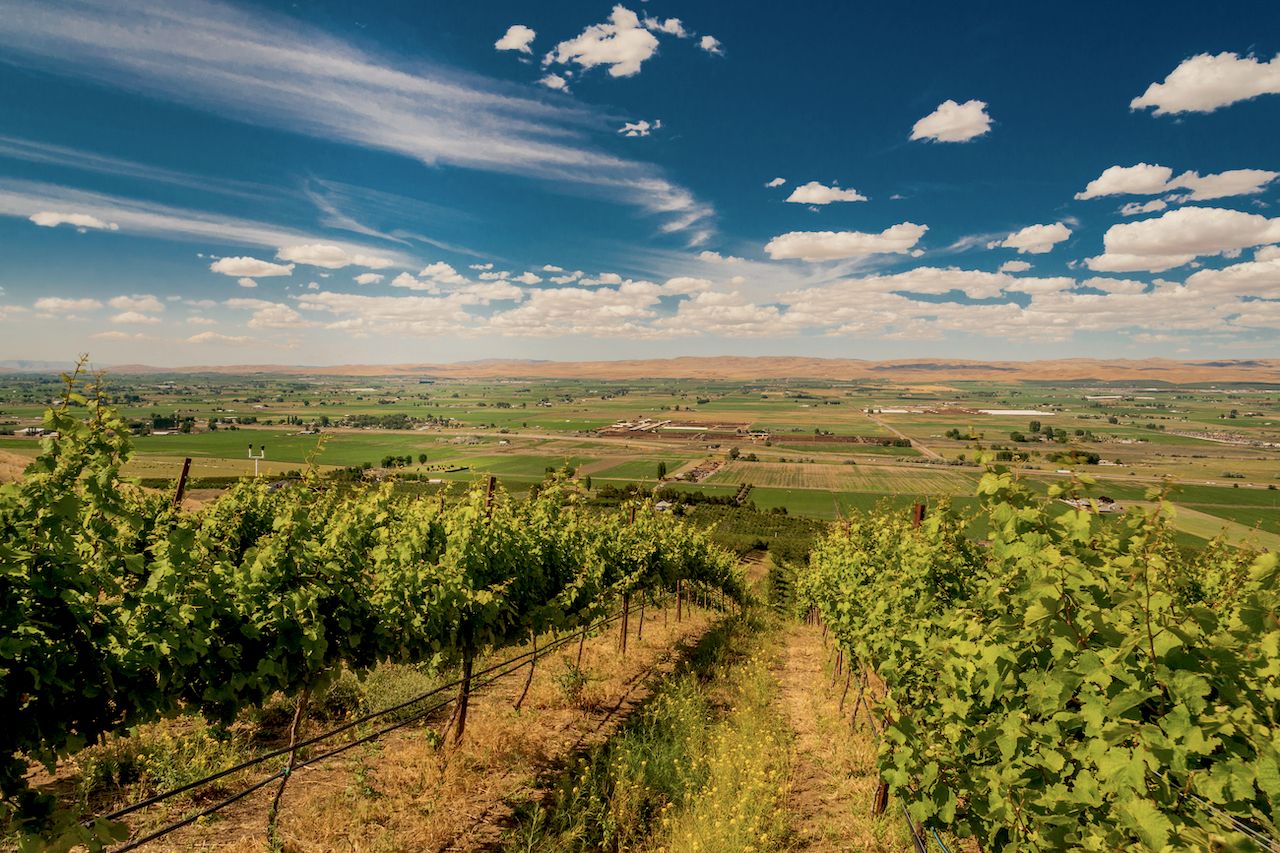
Photo: Danita Delimont/Shutterstock
This small, farming-centric city in central Washington is heaven for anyone who appreciates good beer, fine wine, and fresh produce. For anyone who travels for the food and drinks first and foremost, Yakima needs to be on your list.
Craft beer drinkers are familiar with the flavors of Yakima whether they know it or not. Yakima farmers produce 75 percent of the hops in America, so there’s a good chance that if you’ve had an IPA or two from a craft brewery, you’ve had Yakima hops. The hop harvest starts in late August and goes through September. It’s an ideal time to visit and drink fresh hop beers from local breweries like Bale Breaker and Wandering Hop. The American Hop Museum is a solid location to learn the ins and outs of what makes the Yakima Valley — and the hops it grows — such a special place for beer.
If wine is more your speed, the Yakima Valley is home to more than 17,000 acres of vineyards and more than 120 wineries. More than half of Washington’s famous wine grapes are grown in the valley, but the wineries are laid-back and easygoing unlike some of the name-brand wine destinations in the US. The town itself is a great jumping-off point to explore the urban and rural wineries and tasting rooms.
Finally, a full beer and wine experience in a world-renowned location is nothing without food to match. The Yakima Valley has the largest variety of produce in the Pacific Northwest with more than 1,000 types of fruits and vegetables. There are 90 certified organic farms in the region, and it’s too easy to spend a day wandering the seasonal farmers markets. Restaurants like Cowiche Canyon and Crafted take full advantage of all that Yakima has to offer.
5. Swansboro, North Carolina
Population: 3,273
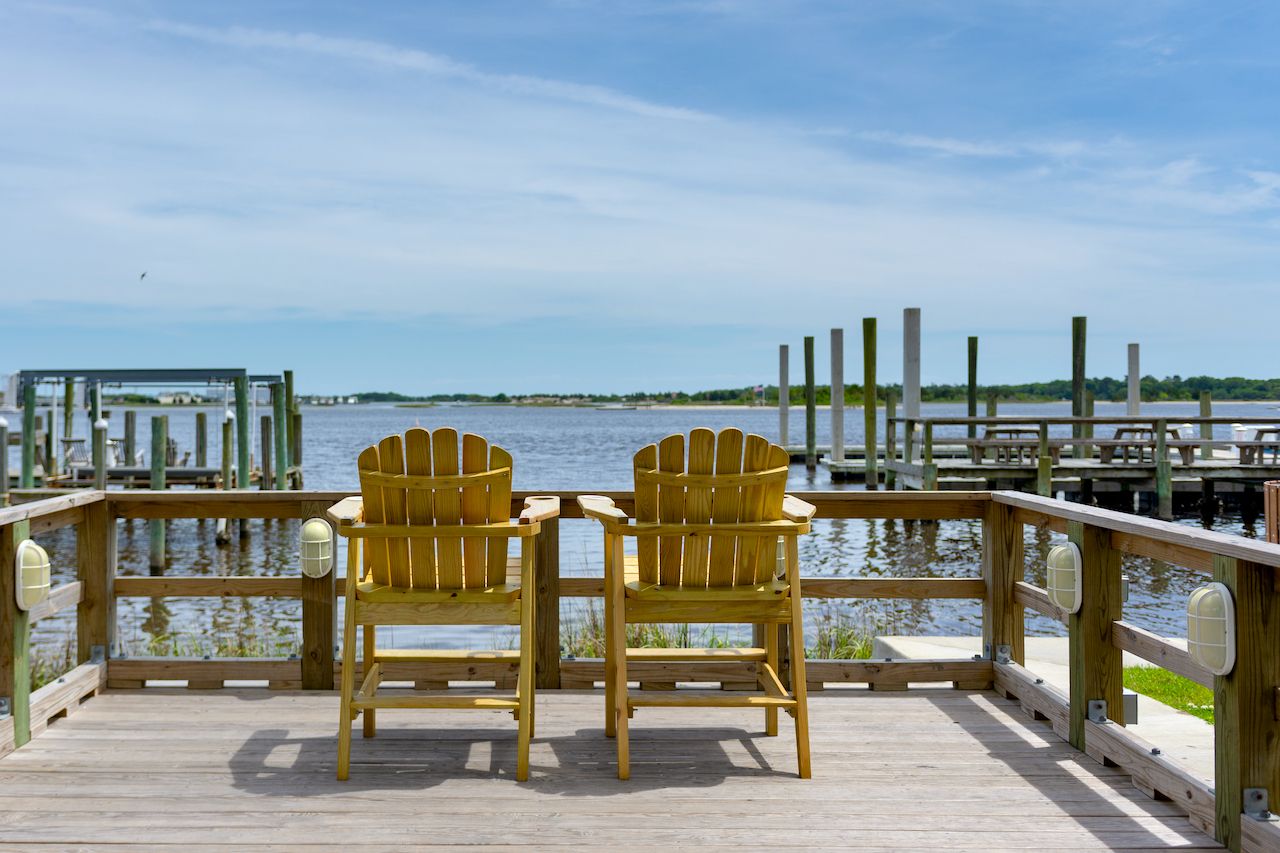
Photo: Eric Krouse/Shutterstock
Padding through the remote white sands and tranquil marshes of Hammocks Beach State Park feels a world away from civilization. Until the gunshots start. It’s not at all unnerving, though; no impending revolutions are happening on the other side of the pine forest. It’s just a field exercise at Marine Corps Base Camp LeJeune, which shares a border with the park. And if you can handle the gunfire, the proximity makes for one of the most unique beach experiences in America.
Hammocks Beach is the crown jewel of Swansboro, a one-time shipbuilding hub that’s comfortably transitioned into a historic destination with North Carolina’s most under-appreciated beaches. Hammock Beach is home to Bear Island, a stretch of completely unspoiled, white powder sand beach that’s only accessible via passenger ferry from the park. Even on a summer weekend, it’s not unusual to be one of the only people sunning under the towering dunes along the shore.
But the beach isn’t the only thing that makes Swansboro so cool. The meticulously preserved downtown has buildings that date back over 100 years. Your first stop should be Bake Bottle and Brew, where you can try beers from all over the state, then counteract the effects with local coffee. It’s also one of those snarky souvenir stores where you’ll find yourself inexplicably buying mermaid potholders you never knew you needed.
Swansboro’s historic downtown has no shortage of places to get a meal on the water, either. You can scarf fresh seafood at Saltwater Grill, which offers an elevated perspective and the city’s best burger, or enjoy any of the cafes along Front Street. Just don’t be surprised if you see an Osprey motoring in for a landing during your lunch.
6. Galena, Illinois
Population: 3,183
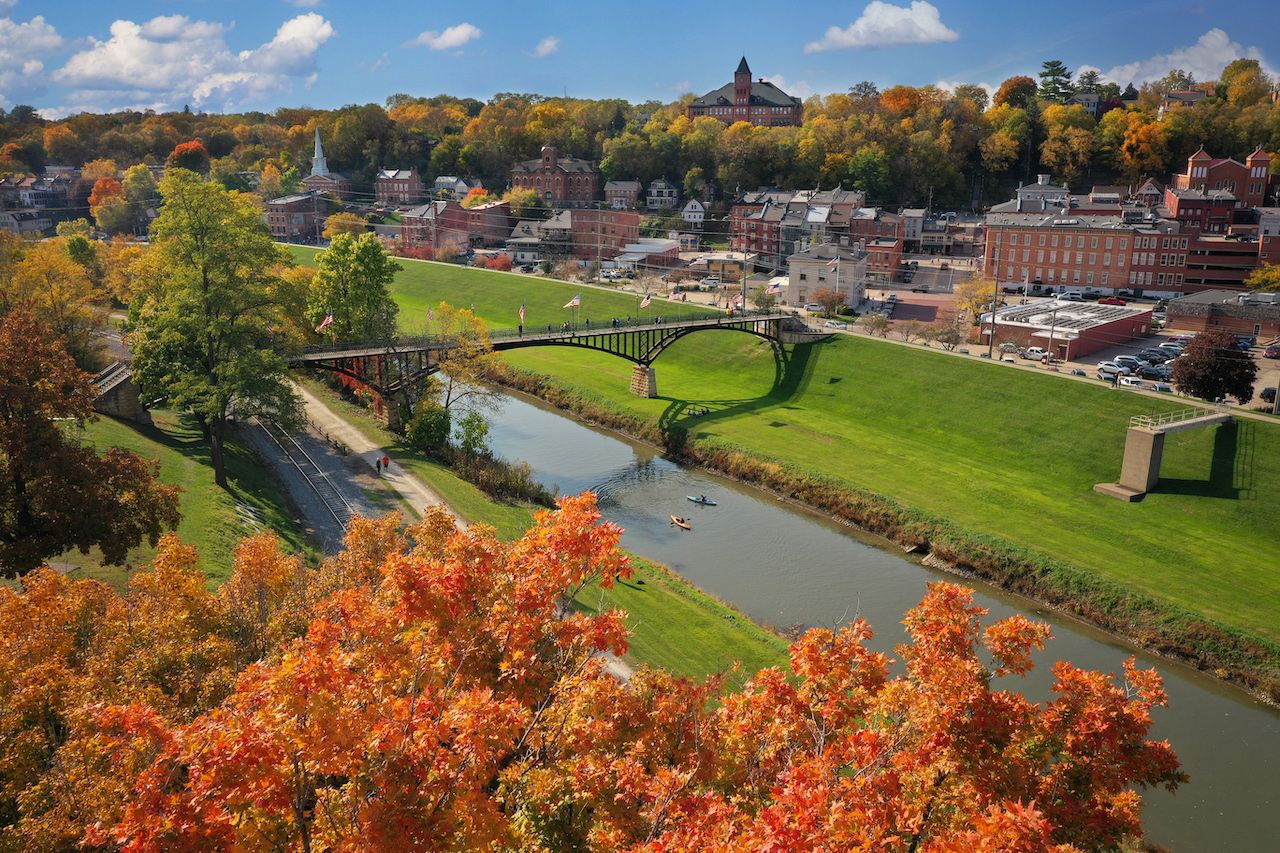
Photo: Galena Country Tourism
Like a cat stuffing itself into a too-small box, Galena wedged itself in Mesquakie and Ho-Chunk territory, deep in the high limestone bluffs halfway between Dubuque and Chicago. An old mining town and steamboat hub — that once rivaled the Windy City in population — the 3,500-person Illinois town is replete with 19th-century stone cottages, over 125 shops and restaurants along its “Helluva Half Mile” main drag, and more history than you’ll know what to do with. Eighty-five percent of the town is on the National Register for Historic Places, including the Ulysses S. Grant Home State Historic Site, home of the country’s 18th POTUS.
To get the full Galena experience, hang your hat somewhere old, like Abe’s Spring Street Guest House (a former icehouse with 27-inch-thick walls) or Abbey’s High Street B&B (an 1850s mansion). Slot time to tour the circa-1826 Dowling House, a limestone beauty that was once the only trading post in the city — back when it was a city.
Reserve at least a full day for wandering Main Street, too, which runs parallel to the Galena River and Galena Grant Park. Nab lunch at Vinny Vanucchi’s for bang-up carbonara at a Galena institution, pop into Galena River Wine & Cheese and the ever-cute Poopsies toy shop, and pinpoint Miss Kitty’s Grape Escape for later libations.
Outdoors, that river you’ve been eyeing is great for paddling (Fever River Outfitters has the hook-up). Or choose one of five hiking trails along the bluffs and ravines of Apple River Canyon State Park (yes, there’s a canyon). For a more laid-back excursion, take a drive along the Great River Road — the one that wends all the way from here to New Orleans.
7. Big Sky, Montana
Population: 3,098
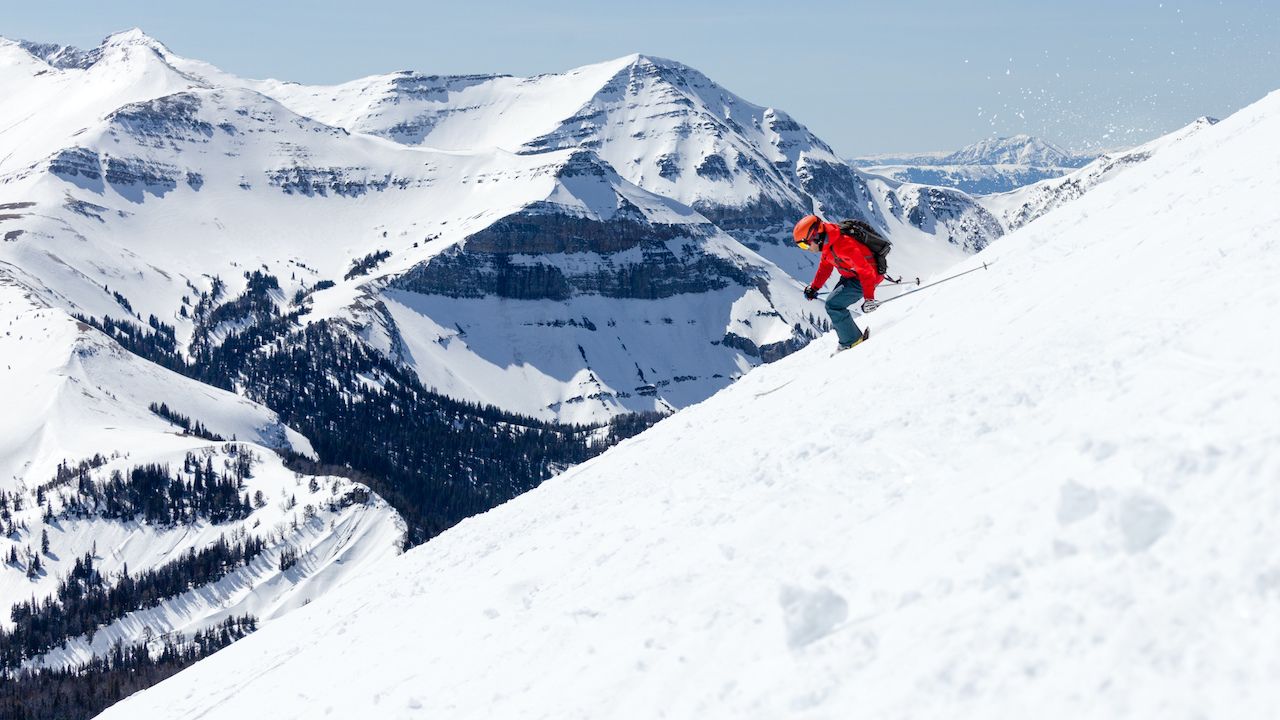
Photo: alexfe/Shutterstock
Big Sky is the exception to the unwritten rule of resort towns being great places to base yourself out of but lousy places to base yourself in. A few days here is enough to make you question your decision to live anywhere else — with 5,800 acres of skiable in-bounds terrain at the resort and an entire range of backcountry to explore, Montana’s best ski town is unique both in its unparalleled access to the outdoors and the rugged-yet-welcoming nature of its residents. (And no, we haven’t seen the soapy new Big Sky TV show, but we’re willing to bet it’s probably not accurate to the real scene here.)
On a winter visit, check into Summit at Big Sky at the base of the Ramcharger 8 lift, which has the country’s most diverse collection of in-bounds ski terrain with something for everyone, from beginners to the diehards summiting Lone Peak. In summer, hiking, zip-lining, mountain biking, and world-class golf are all available right from town.
Locals and travelers alike congregate at Beehive Basin Brewing and Choppers Grub and Pub in the early evening to swap stories of the day’s outings. The Horn and Cantle restaurant at Lone Mountain Ranch epitomizes mountain-town fine-dining with farm-to-table meats, seafood, and veggies, plus an incredible cocktail menu. Within walking distance of one another, downtown’s Lotus Pad (Thai), China Cafe, and Blue Buddha Sushi Lounge make for a highly concentrated circle of top-notch Asian cuisine, while Westward Social at the ski resort’s base area is the place for laid-back bar games and cutting loose.
8. Frederick, Maryland
Population: 70,166
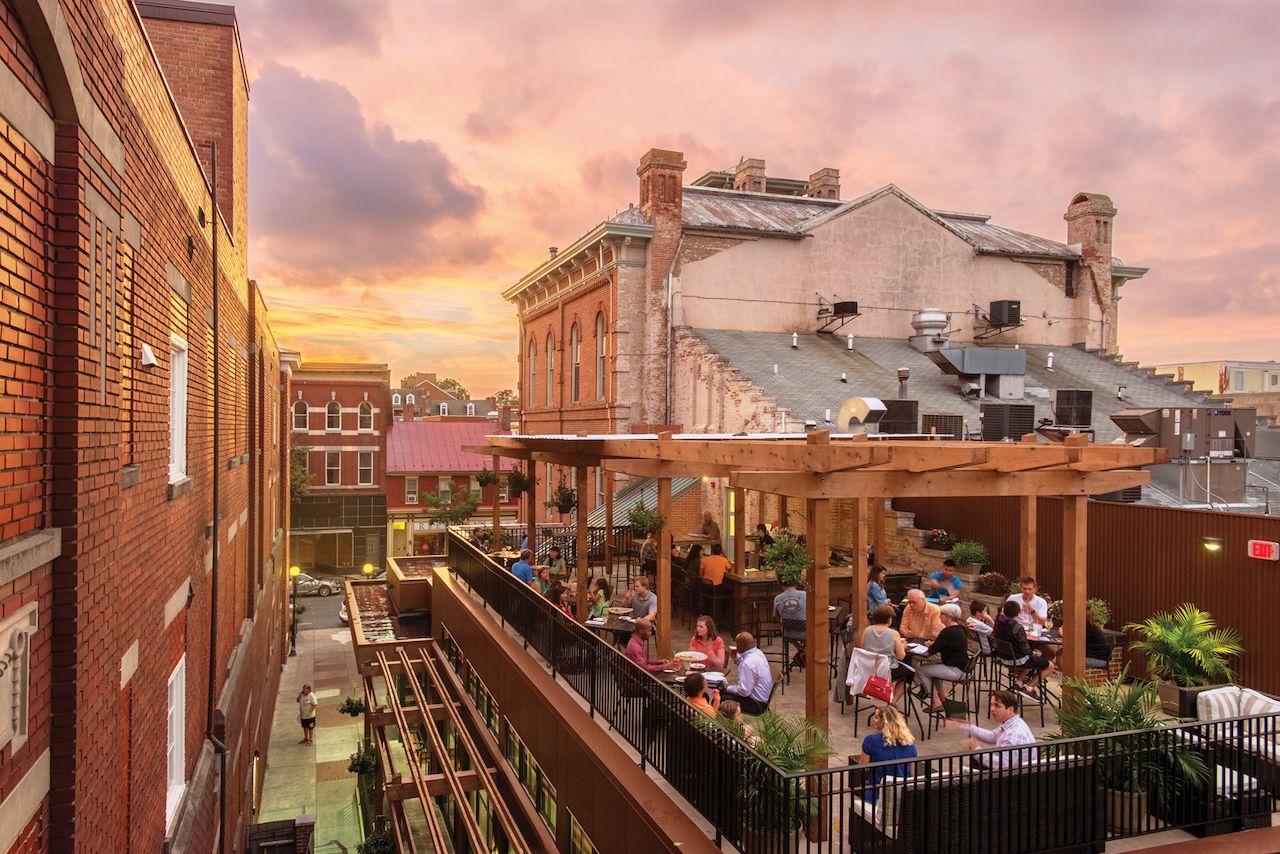
Photo: Natural Artistry / Visit Frederick
Forget about DC — Maryland is the culinary epicenter of the Mid-Atlantic, and nowhere is that truer on a small-city level than Frederick. Frederick attracts visitors with its colorful downtown, Civil War history, access to the Catoctin Mountains, and art scene, but it’s the food and drink culture that makes this town worthy of more than just a quick day trip.
The 50-block historic district is where you’ll want to start. It’s home to colorful buildings, local boutiques, museums, and some of the region’s best restaurants and breweries. If you’re ready to dive right in and indulge, check out the new Thatcher & Rye from Top Chef All-Star Bryan Voltaggio (which recently replaced his flagship restaurant, VOLT). For a slightly more relaxed environment, the Born & Raised diner is located in a former car dealership on the outskirts of downtown, giving you a contemporary take on the classic diner concept.
Frederick is equally enthusiastic about drinking. The Flying Dog Brewery has its award-winning beers like Dead Rise on tap while the Milkhouse Brewery at Stillpoint Farm specializes in small-batch farm-to-glass ales. Frederick also has a gorgeous wine trail that winds through the county’s hills, with stops at Hidden Hills Farm and Vineyard, Springfield Manor Winery & Distillery, Linganore Winecellars, Loew Vineyards, and more. Be warned — the trail might turn into your own version of “Drunk History” as it crosses Civil War battlefields and other historic sites, including Monocacy National Battlefield and South Mountain Battlefield State Park.
Don’t leave before exploring the city’s Arts & Entertainment District, which has both indoor galleries and outdoor public art, like local favorite “The Community Bridge Mural” by William Cochran. You can also catch a play at the Maryland Ensemble Theater or the Weinberg Center for the Arts — a cinema dating back to 1928.
9. Saugatuck, Michigan
Population: 960
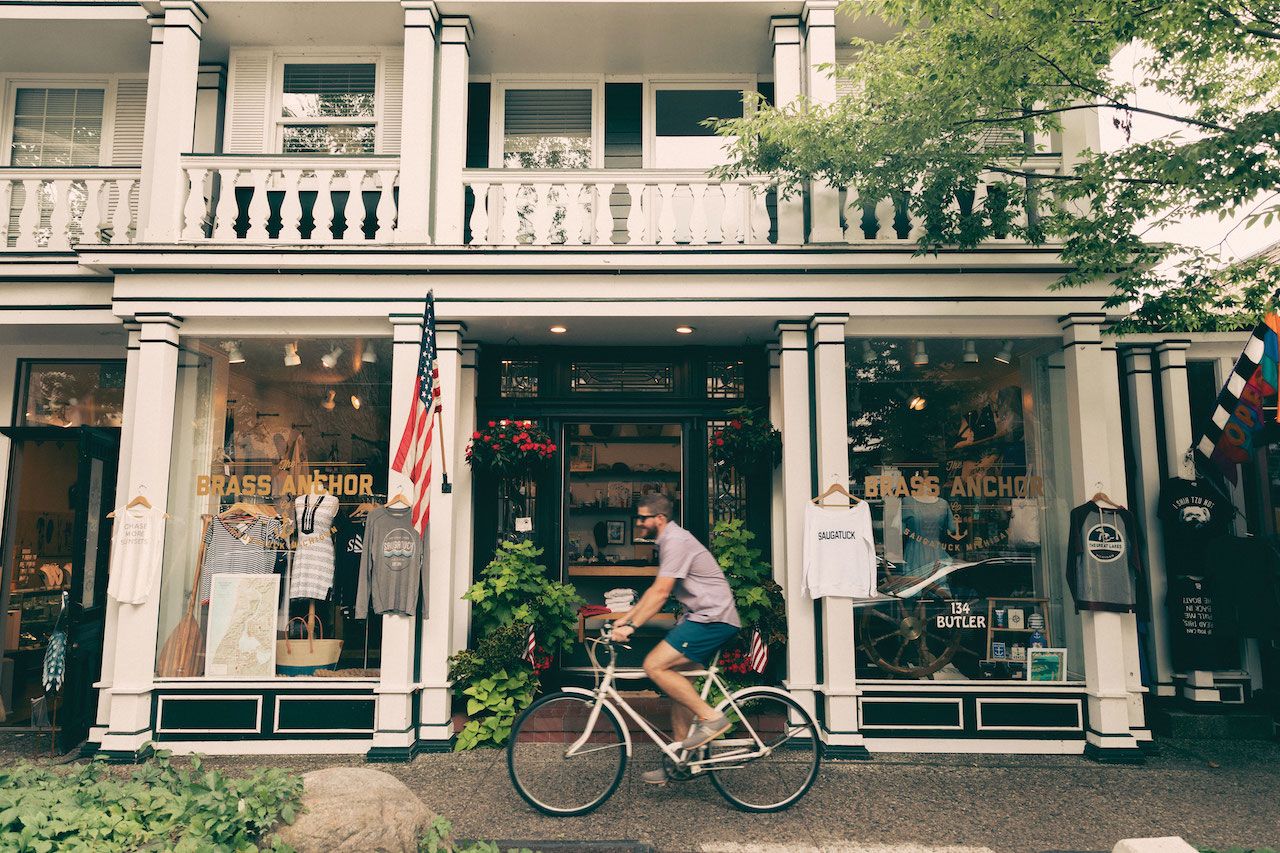
Photo: Ollie’s Journal / Saugatuck/Douglas
On the shores of Lake Michigan — abutting the world-class Oval Beach — tiny Saugatuck has made itself a major Midwest destination. A beautiful shoreline, an LGBTQ+ hotspot, an art-loving community, and a playground of sand dunes and river adventures, it’s no wonder why this little 960-person town draws people from all over the country.
For starters, this is the “Art Coast of Michigan.” Check out the Amazwi Contemporary Art Gallery, dedicated to African art, or immerse yourself in a week-long class at the Ox-Bow School of Arts (a branch of The Art Institute of Chicago). The food here is more artfully minded than you might expect, too — try Pumpernickels for breakfast underneath a hanging forest; grab lunch at local-institution The Butler, right on the waterfront; and for dinner, head to Bowdie’s Chophouse for porterhouses, prime rib, and ribeyes that have won almost as many awards as the town’s beaches. You can also take your pick of wineries, breweries, or cideries — Virtue Cider is a true delight.
To burn off those calories, climb up the sand at Saugatuck Dunes State Park, where 13 miles of trails wind along 1,000 acres of Lake Michigan shoreline — or you can climb down the long stairway to Laketown Beach for a more private Saugatuck experience. When the day is over, head to a bed and breakfast like the European-style Belvedere Inn — the B&B scene in Saugatuck is just how you do it. It’s worth noting, however, that the Hotel Saugatuck offers guests complimentary bicycles, which is a great way to get around the town and to the beach.
10. Port Salerno, Florida
Population: 11,317
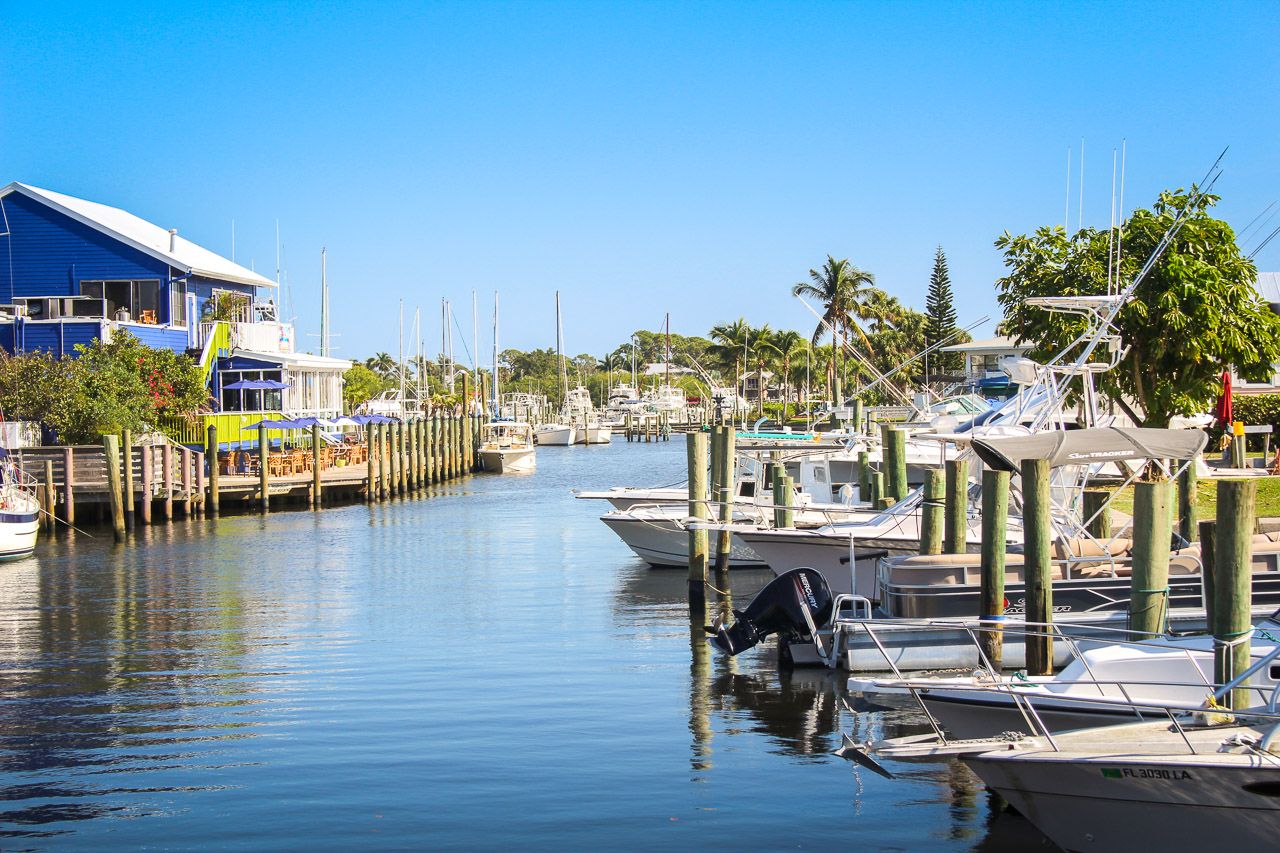
Photo: Martin County Florida
Most Florida fishing towns aren’t anything all that remarkable. But a fishing town where you’ll run into the ghost of Florida’s most notorious bank robber? That’s the stuff of Hollywood imagination.
Port Salerno, the “most haunted fishing town in America,” is set along Florida’s Treasure Coast between the Palm Beaches and the space shuttles. It grew into the commercial fishing capital of southern Florida but not before bank robber John Ashely and his gang made it their Florida hideaway. The Ashley Gang was ultimately informally executed on a road outside town, and Ashley’s ghost still hangs around the waterfront making trouble for patrons at waterfront bars. Take the fascinating, if a little disturbing, two-hour Port Salerno Ghost Tour to learn about the Ashley Gang and the many other ghosts that loiter around the waterfront.
That waterfront is where you’ll find the artists drawn to Port Salerno by its funky, spooky vibe. Tour through their works at Fish House Art Center and Gallery, which houses galleries, an ice cream shop, and a big outdoor bar in the middle. From there, walk about a hundred feet to the Twisted Tuna, 10,000 feet of seafood fresh from the docks and waterfront views. There are, of course, also abundant opportunities to get out on the water, from deep-sea fishing to just paddling the soft, balmy waters of Manatee Pocket.
The town may feel like the setting of a supernatural suspense thriller, but it’ll surprise you with its friendliness and color. Not all the ghosts here are as welcoming as the locals, but it’s the kind of place where you stop in somewhere for a beer and learn way more than you bargained for.
11. Fruita, Colorado
Population: 13,406
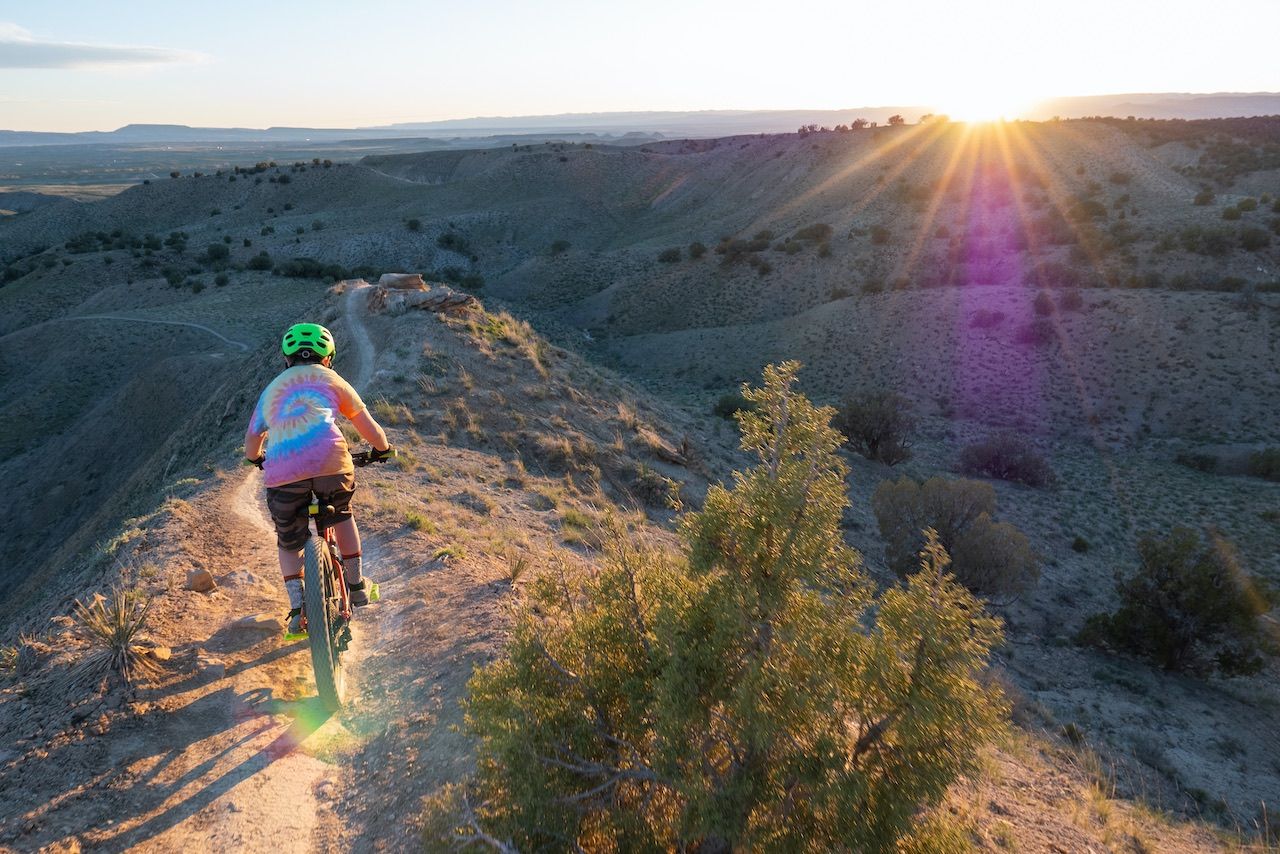
Photo: GROGL/Shutterstock
Few towns in America have flipped perceived fate on its head in the way Fruita has. Powered by an upstart bike shop and a community of dedicated riders, the mountain biking scene picked up where oil and agriculture left off in the mid-’90s, literally saving the town from bankruptcy and establishing it as a destination for bikers the world over. With trail systems sprawling from the rolling hills of the Bookcliffs north of town to the banks of the Colorado River to the south and plenty of hiking and fishing to boot, Fruita is an outdoorsman’s paradise in a part of the country where economic development increasingly depends on recreation-based tourism.
The Colorado town itself is as quirky as any on this list. The entirety of downtown is laden with bike-themed public art worthy of a stroll during daylight hours. Your first stop in Fruita after dismounting your bike should be The Hot Tomato, a pizzeria run by a pair of innovative mountain bikers that have turned their restaurant into a gathering place for hungry and thirsty bikers, as well as the subject of a documentary film produced by Patagonia. Copper Club Brewing Company, just around the corner, is a cozy pub that beckons for a pint and is the place to meet before a night out along Aspen Avenue.
Camping is the preferred accommodation for many visitors, with trailside campsites available next to the 18 Road mountain bike area and at multiple points along the Colorado River in James M. Robb State Park. In town, opt for the Balanced Rock Inn, a motel within walking distance, or a few pedals on the bike, of the restaurants and pubs downtown.
12. Bristol, Rhode Island
Population: 22,954
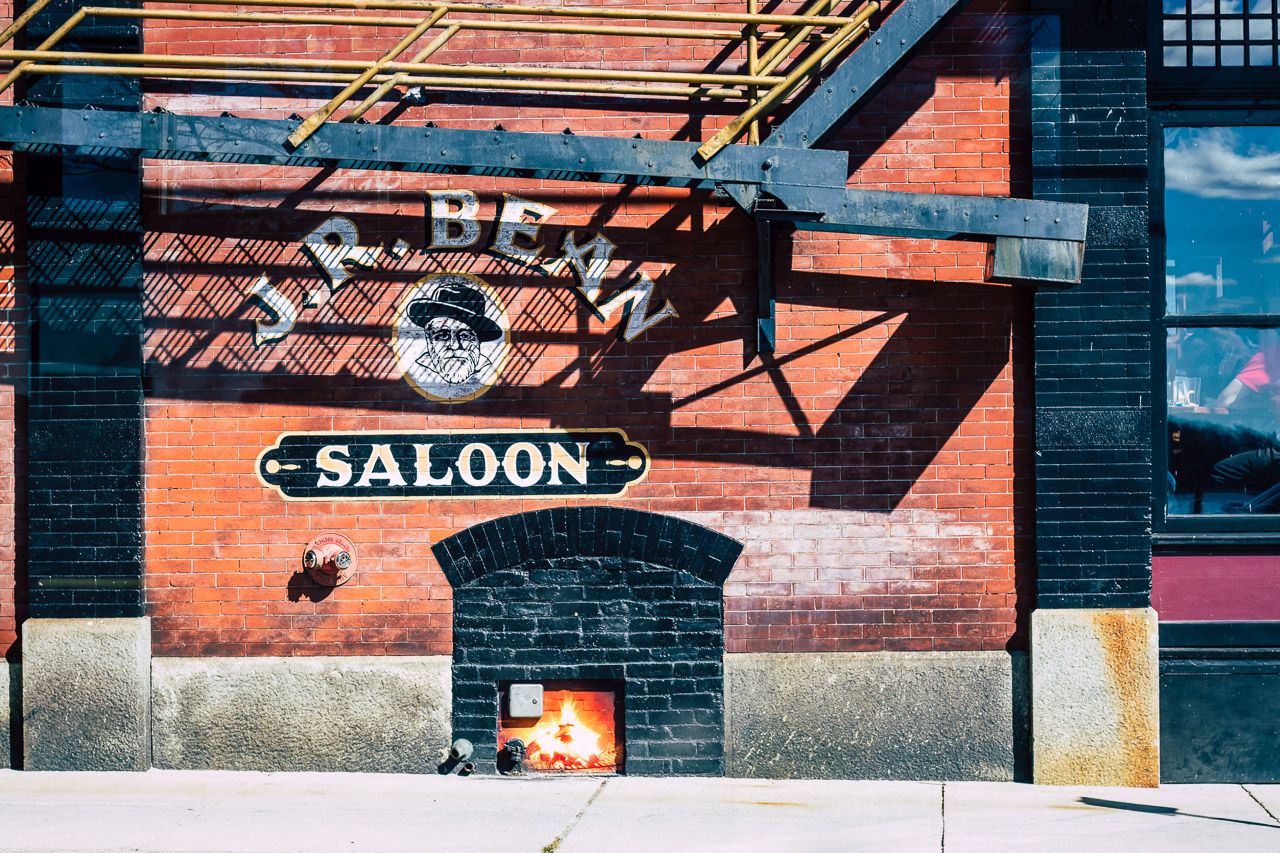
Photo: Mike Fig Photo/Shutterstock
Though Rhode Island is the smallest state in New England (and the country, for that matter), it’s the one that perfectly encapsulates the region’s charm. A 10-mile peninsula extending into Mt. Hope Bay, Bristol is the quintessential New England coastal town with a well-preserved waterfront district, historic ports, and old captain’s mansions dating back to the 17th century.
There is an abundance of kayak trails around the bay, but the best way for landlubbers to experience Bristol’s waterfront is probably at Colt State Park. With 464 acres of bike trails, budding flora, stone walls, and picnic groves, the entire western border of the park abuts Narragansett Bay with views that don’t disappoint.
Although nearby Newport is more renowned for its stately homes, Rhode Island’s most impressive mansion might be the Blithewold Mansion & Arboretum in Bristol. Surrounded by 33 acres of gardens brushing up against Bristol Bay, this 45-room manor home will take you back to the city’s vibrant seafaring culture of the late 19th century.
Home to Roger Williams University, Bristol’s bars and restaurants come with college town prices — and nightlife, if you’re looking for it. Aidan’s Pub and Judge Roy Bean Saloon are two popular haunts for the student population, both serving affordable pub fare. If you’re not trying to consume questionable tequila shots with a bunch of undergrads, check out Thames Waterside Bar & Grill. It has a patio overlooking the harbor and all the seafood New England is famous for.
Bristol is also the place to be on the Fourth of July. The city is home to the oldest continuous Fourth of July parade in the entire country, running for 235 years. Main Street is painted red, white, and blue; flags wave from the stoops; and a National Guard flyover punctuates the patriotic display.
13. Columbus, Georgia
Population: 197,485
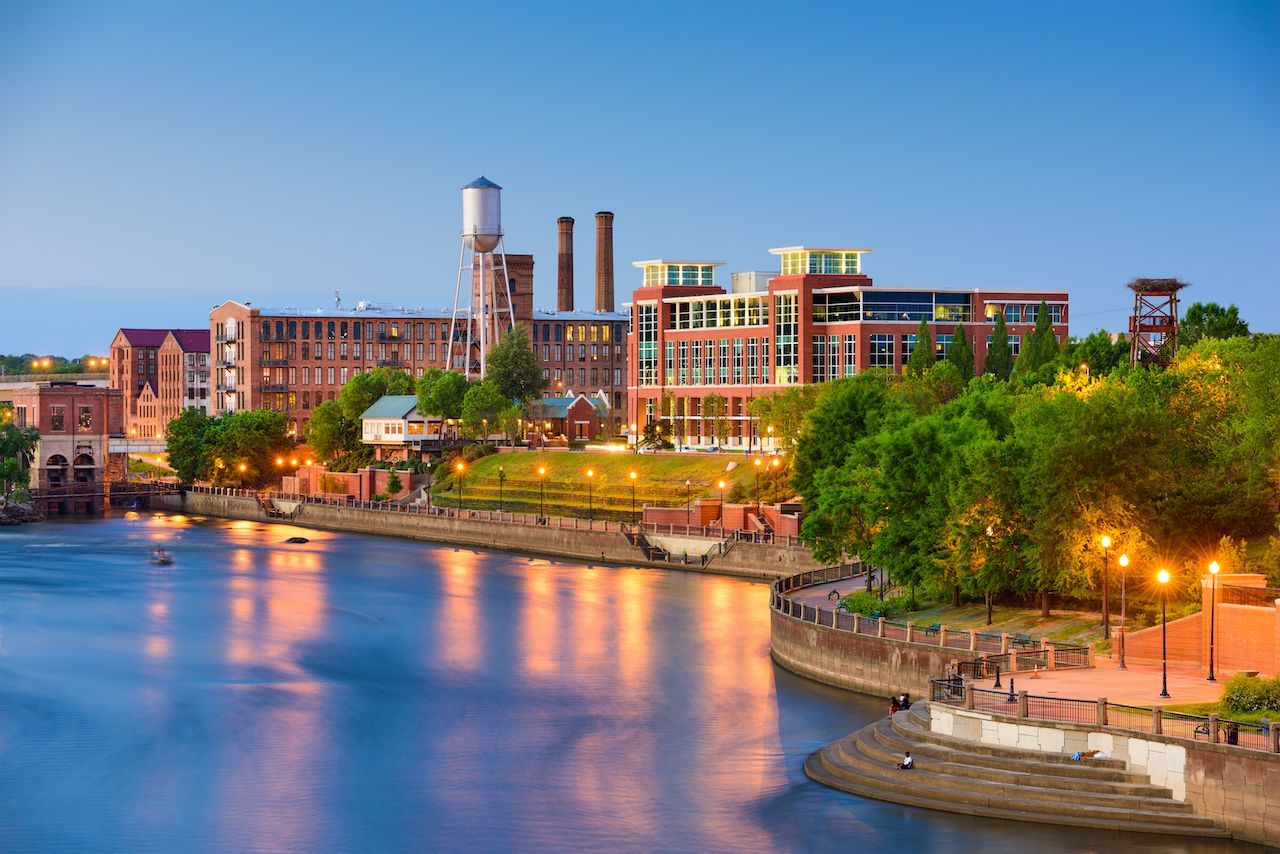
Photo: Sean Pavone/Shutterstock
Columbus may be the third biggest city in Georgia, but it has the feeling of a small, close-knit town. The city sits on the Chattahoochee River and borders the state line that separates Georgia and Alabama. The Chattahoochee was the lifeblood of the town through much of the region’s early history thanks to its importance in trade and transportation. Today, it’s the lifeblood of the city’s outdoor recreation.
Whitewater Express offers the longest urban whitewater rafting run in the world. The course has more than five rapids that are class four or higher, as well as 10 smaller rapids — a range that’s perfectly doable for newcomers and interesting enough for experienced whitewater rafters. If you’d rather experience the river from the air rather than the water, complete a zipline course from the Georgia side of the river to the Alabama side and back again. There’s nothing wrong with taking things a little slower on the river either, though. The Chattahoochee Riverwalk is a 15-mile bike and walking path with the river on one side and the city — a mix of historic buildings and modern bars and restaurants — on the other.
Columbus has a thriving arts and museum scene to match the outdoor activities. The River Center For The Performing Arts showcases regional and national musicians in a gorgeous modern venue not far from the main street. The Columbus Symphony Orchestra is one of the premier ensembles in the Southeast and was the second orchestra started in America in 1855. Visual artists have a strong presence, as well, thanks to the Columbus Museum, Columbus State University, and galleries like Black Art In America and Gallery On 10th. The immersive Coca-Cola Space Science Center is a worthy stop for anyone who is a fan of science museums.
Finally, don’t forget about the food. One must-try is the scrambled dog (a regional hot dog specialty from Dinglewood Pharmacy that’s more chili dog than hot dog) while Chattabrewchee Southern Brewhouse and Cannon Brew Pub have your craft beer desires covered.
14. Stillwater, Minnesota
Population: 19,404
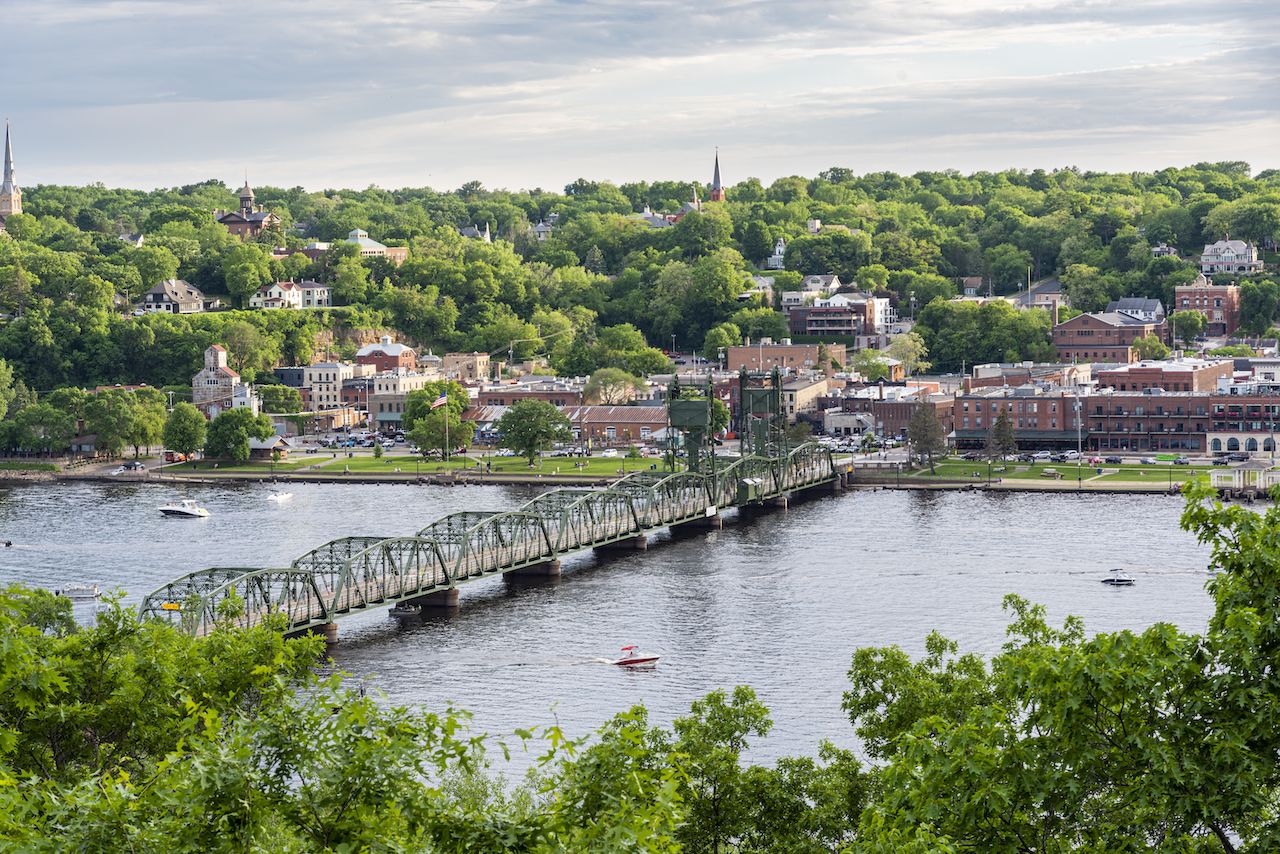
Photo: Dave Parker / Discover Stillwater
Okay, we admit it: Stillwater is on this list because it’s simply darling. Sitting on the banks of the St. Croix River before it flows into the Mississippi — just 30 minutes east of Minneapolis — Stillwater looks like it’s permanently stuck in Hallmark’s holiday rom-com line-up. The “birthplace of Minnesota,” vintage paddle boats populate the waterways, outdoor staircases flow up and down the bluffs, and brick-laden turn-of-the-century beauties fill the historic downtown.
Clearly, the town is always gorgeous, but the four very distinct seasons will determine what type of gorgeous you’re surrounded by and how you’ll experience the outdoors: In the warmer months, kayak the flatwater around Interstate State Park or go hiking up the craggy bluffs and count glacial potholes and lava flows; once the snow inevitably piles up, rent cross-country skis at 45 Degrees and shoosh-shoosh through the expansive William O’Brien State Park or send yourself downhill (well, 300 feet downhill) at nearby Afton Alps. Sunrise snowshoeing at Lake Elmo Park Reserve breaks up the winter blues every time, too.
Downtown buzzes any time of year. Spend an afternoon unwinding at The Valley Bookseller and Oasis Cafe, take lunch on one of the 20-plus patios, and go underground at speakeasy-esque The Velveteen at night. Consider buying a day pass to industrial-chic Lift Bridge Cowork (above Mon Petit Chéri Bakery & Kitchen) to test-drive the digital nomad life in one of Minnesota’s oldest towns, and you might be persuaded to stay in town for a while.
15. Vernal, Utah
Population: 10,370
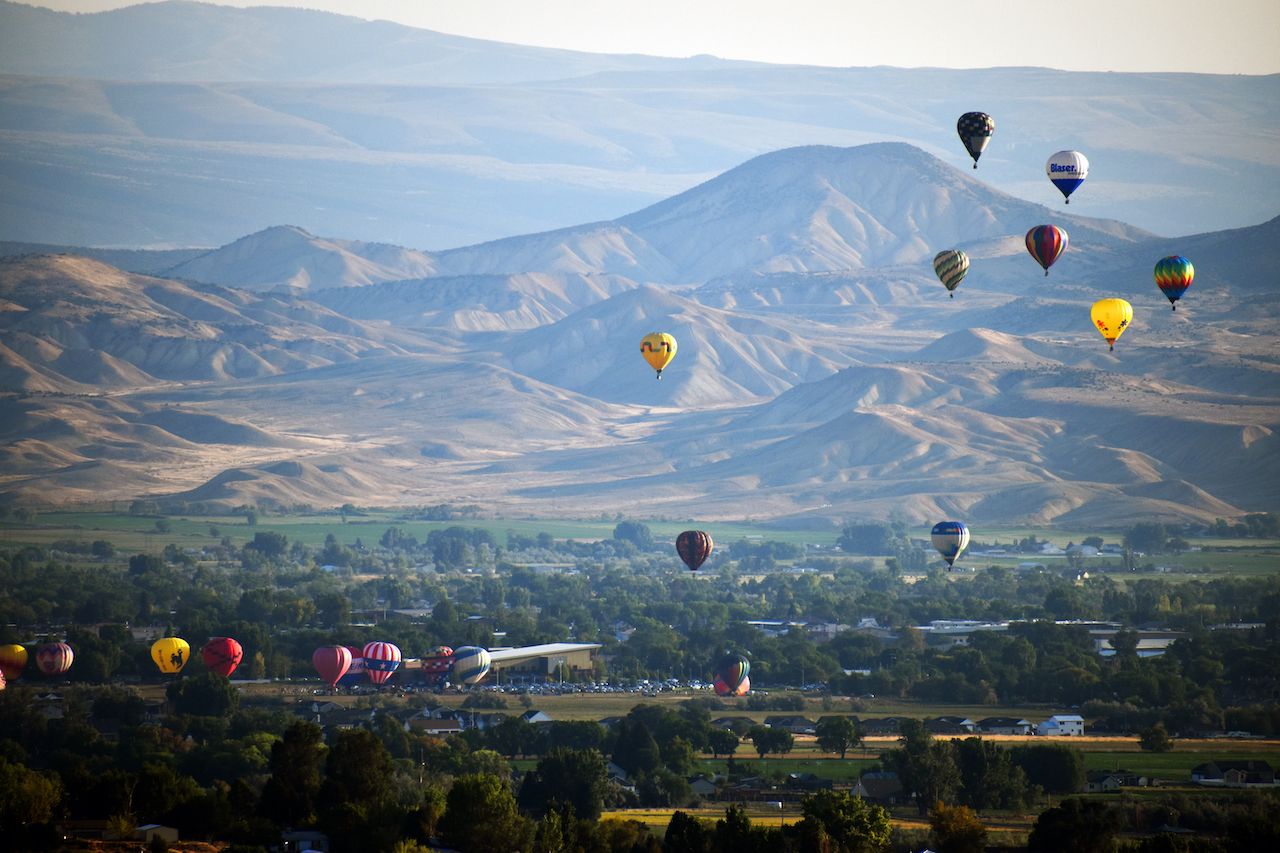
Photo: Kevin Nading / Visit Dinosaurland
As Butch Cassidy discovered in the 1860s, Vernal is the easiest town in America from which to escape civilization. Indeed, a trip here rarely actually means spending more than a few hours in the town itself. Rather, this northern Utah outdoors hub is a basecamp for climbers, river rats, mountain bikers, and backcountry hounds seeking easy access to the goods they’ve spent their lives pursuing. The Western Battleship Formation, Dinosaur National Monument, and Flaming Gorge National Recreation Area are all a day trip away, and the town itself is surrounded by trail systems to rival those of Moab.
The only thing lacking in Vernal is pretension — it’s the type of place where adventurers are too busy actually adventuring to shun you for not being on their level. Dedicated adventure outfitters such as OARS operate from downtown and into the surrounding canyon country, though all you really need is a good trail map to find your own adventure.
And then there are the dinosaurs — enough of them that the area has long been dubbed “Dinosaurland.” Stop by Dinosaur Gardens and the Utah State Field House Museum to learn about the area’s history as a hotspot for the ancient reptiles, and then head out to the Dinosaur National Monument Quarry to walk through their grounds. After your adventure, pull up a stool at Vernal Brewing Company or Dinosaur Brew House. Or, because nothing follows the stoke of finishing a trail quite like a margarita, head into Don Pedro’s, La Cabana, or Mi Casa.
16. Thibodaux, Louisiana
Population: 15,056
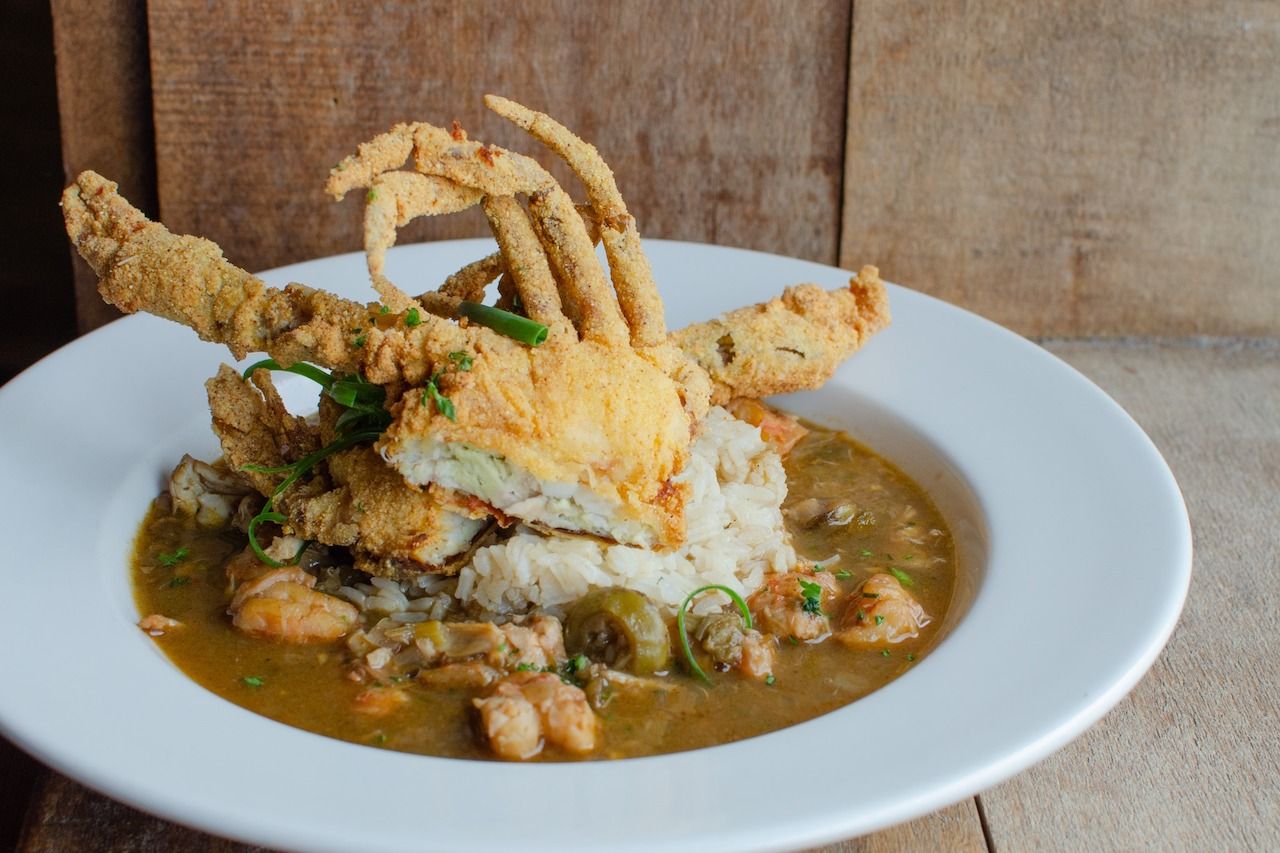
Photo: Cinclare/Facebook
A visit to the Louisiana Bayou might begin with the hope of going on a marsh tour, seeing alligators, and maybe eating some gumbo. You’ll quickly discover, however, that the food forces everything else into a supporting role. Thibodaux, the gateway to the Bayou, is a place to eat rather than see. The only thing that gets Thibodaux residents more excited than watching a Nicholls State football game is chowing down at the tailgate. There’s no denying the care and preparation that goes into Cajun cooking.
Hit up Bubba’s II PoBoys and Seafood for po’boys; they’ve been perfecting them for decades. Then travel further down the Bayou to visit Rose’s Cafe in Galliano. The cafe opens early to cater to local fishermen and tugboat workers, who sometimes give their fresh catches to the chefs to fry up for them. If you don’t feel like catching your own meal, the S.O.S. (Shit On a Shingle) — pork sausage in white gravy on a biscuit — and shrimp platters are Bayou staples. Back in Thibodaux, cap the day off with gourmet fare at Cinclare Southern Bistro, famous for its savory alligator and andouille cheesecake.
If you’d rather snap pictures of alligators than ingest them in cheesecake form, Airboat Tours by Arthur in nearby Des Allemands will bring you right out on the swamp. You’ll meet local gator celebrities like Bubba, Alice, and her “boyfriend” Big Al, all while cruising under haunting curtains of Spanish moss.
If it’s the right season, don’t miss a Nicholls State University tailgate. Families and local businesses set up tents as far as the eye can see, and most will be more than happy to serve you a hearty helping of homemade jambalaya or shrimp etouffee.
17. Maplewood, New Jersey
Population: 25,232
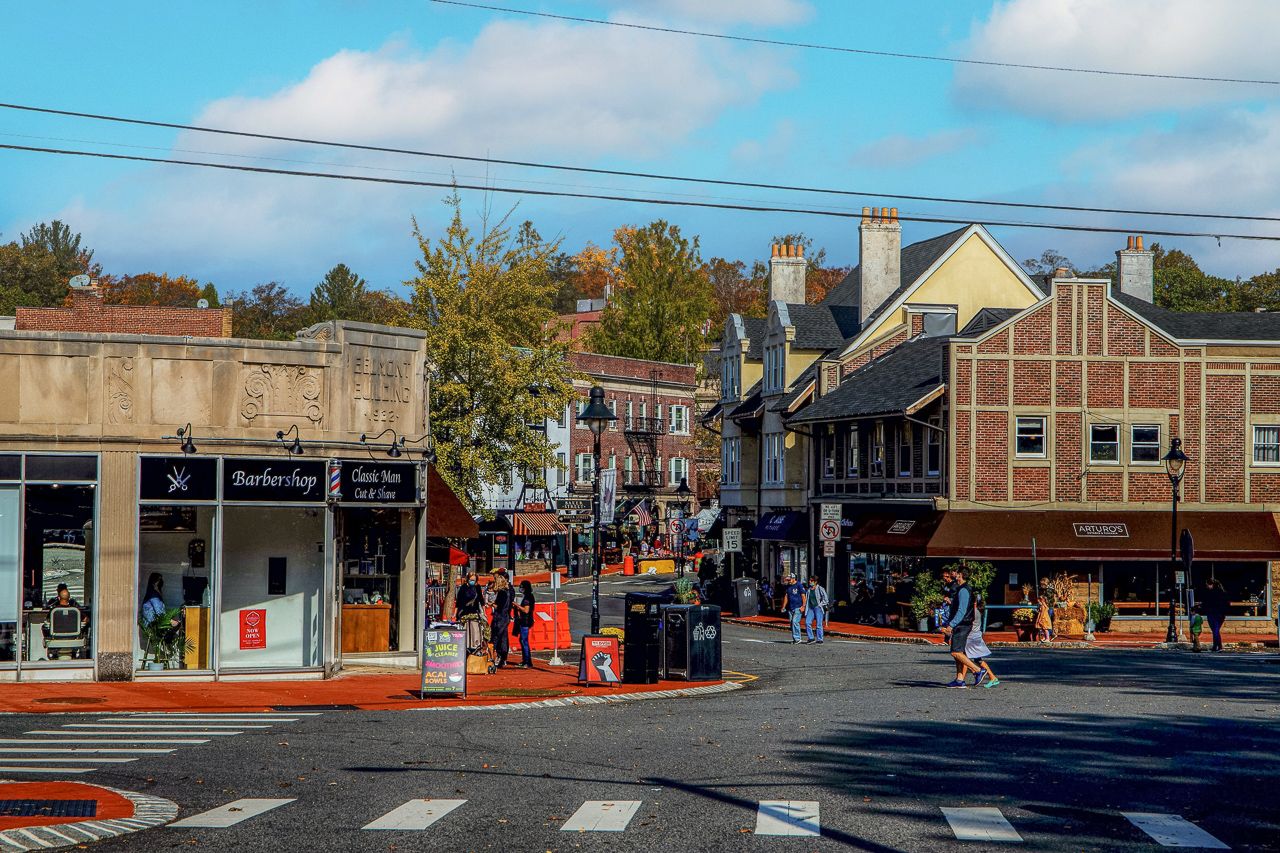
Photo: Carl Patterson / Maplewood Chamber of Commerce
In this beautiful New Jersey suburb, Magnolia trees blossom in the spring, lending the neighborhood a storybook quality. Though Maplewood is just a short 30- to 45-minute commute from New York City and Jersey City by car, you probably won’t want to leave once you get there.
Art appreciators and free spirits of all kinds will thrive in Maplewood, where they’ll find spots like the Rebel Folk Studio, which describes itself as a space for “humans embracing the non-traditional.” The town also hosts the annual Maplewoodstock Music and Art Festival, a two-day jamboree packed with musical performances that encourages families to bring lawn chairs and picnic baskets to Memorial Park. During the summer, Porchfest invites neighbors to gather on grassy knolls on closed off streets and enjoy musical performances.
Speaking of parks, Maplewood is dotted with lush green spaces. In addition to the sprawling Memorial Park, Maplewood is home to the Wildflower Sculpture Park and Maplecrest Park. In fact, Maplewood is the ideal place to experience New Jersey’s natural landscape. Hemlock Falls is nearby, as are parts of the South Mountain Reservation, which covers 2,112 acres and features at least 22 hikes.
If you prefer the indoors, you might enjoy Maplewood’s bookstore, Words. After perusing the shelves, check out the extensive collection of bottles at Wine Barrel. Cap the evening at one of Maplewood’s many restaurants, from the romantic Restaurant Lorena’s to the classic Italian spot Arturo’s Osteria and Pizzeria.
P.S. Want to know the town’s best-kept secret? It’s The Jitney, a white school bus that picks up residents and drives them to Maplewood Train Station — a generous gesture that speaks to Maplewood’s community spirit.
18. Rapid City, South Dakota
Population: 75,443
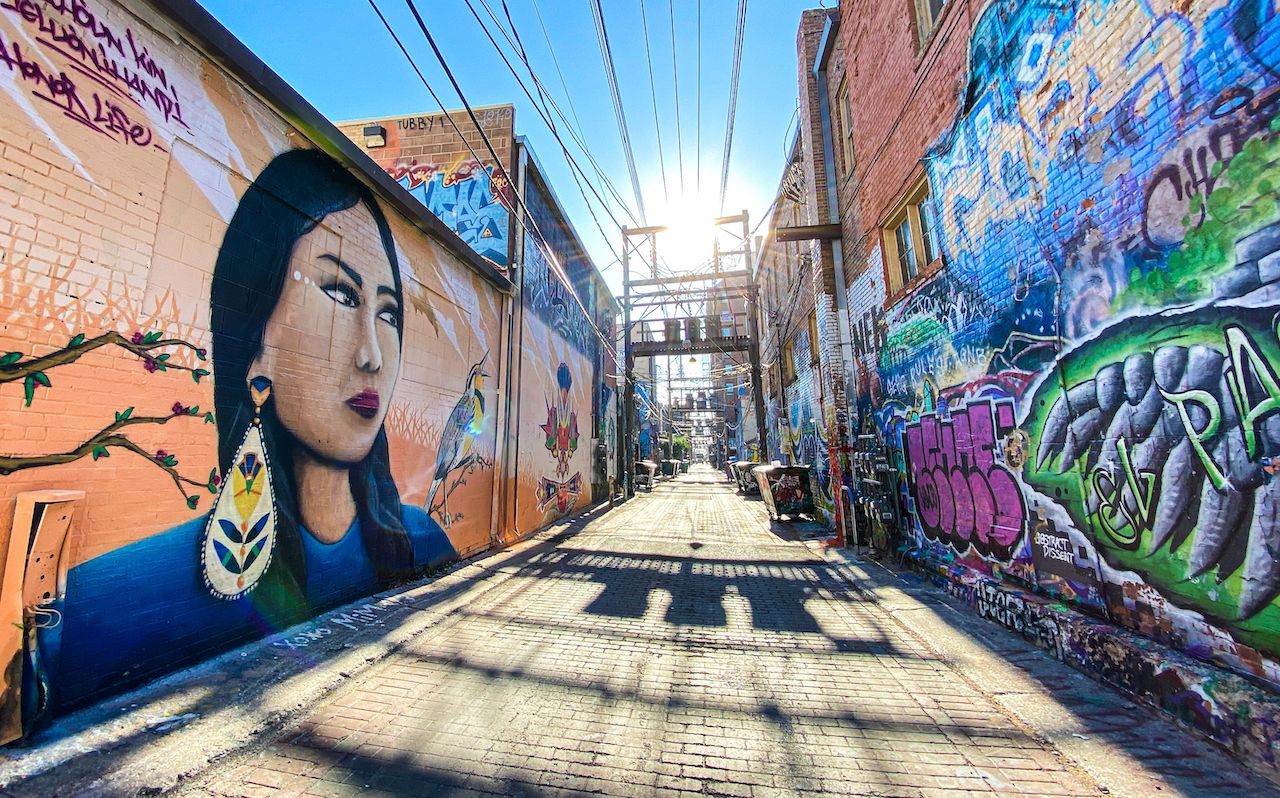
Photo: Visit Rapid City
If you’ve done the enviable road trip through South Dakota to the Black Hills and Mt. Rushmore, chances are you’ve at least passed through Rapid City, full of bright green hills and grain silos in the middle of downtown. Maybe you stopped for lunch or even stayed overnight. But the gateway to the Black Hills is worth a lot more than a stopover.
If South Dakota has a creative heartbeat, it’s in Rapid City. Park your car along 6th Street and you’ll quickly discover a town that feels nothing like the surrounding farmland. Rapid City’s icon is the Hotel Alex Johnson, a 1920s gem adorned with antler chandeliers that’s now a Hilton Curio Collection property. Right under its bright neon sign is a two-level rooftop bar with sweeping views of the Black Hills. It’s the best vantage point you’ll get of the region without an hours-long hike.
Back on street level, wander into Rapid City’s Art Alley, a stretch of murals running between 6th and 7th Street that appears as if someone dropped Miami’s Wynwood art district in the Dakotas. Within a few blocks are three downtown breweries — Hay Camp, Dakota Point, and Firehouse — the latter of which is also a restaurant and live music venue. And you can’t leave town without getting breakfast at Tally’s Silver Spoon, which brings gourmet crepes and waffles to the Black Hills.
You’ll probably have a decent wait at Tally’s, so kill time by walking around and taking pictures of the 44 US presidents whose statues dot corners throughout downtown. After breakfast, check out statues of even older relics by taking Skyline Drive to the Dinosaur Park, which has life-size mock-ups of your favorite dinos set against the backdrop of the city skyline.
19. Tyler, Texas
Population: 105,729
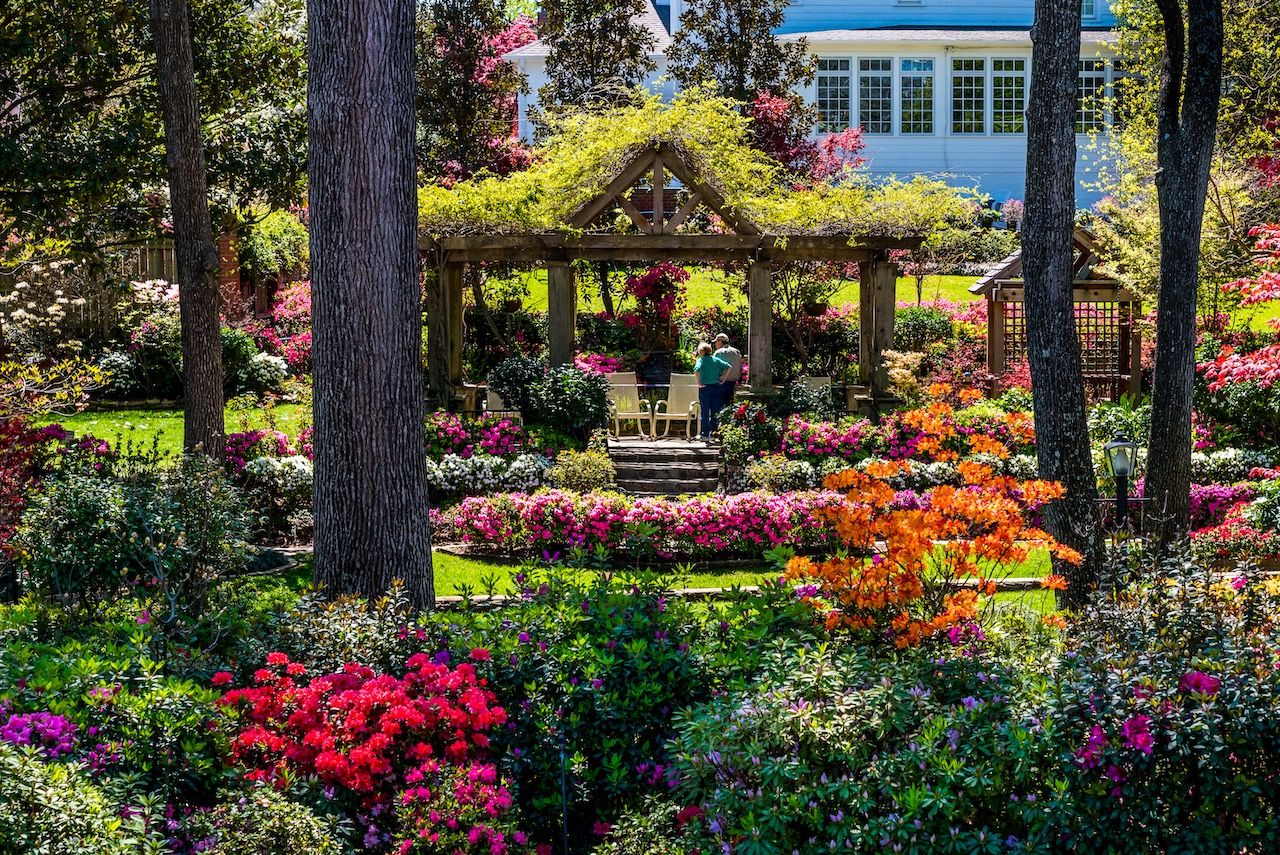
Photo: Ronald Rang / Visit Tyler
Pasadena may have the Rose Bowl, but the rose capital of America is inarguably Tyler, Texas. This town about 100 miles from Dallas is a world apart from the Metroplex and is the odd city in America whose identity revolves around a flower.
Tyler gained the unofficial “rose capital” title around the turn of the century when its once-booming peach industry began to literally rot from disease. A group of recent European immigrants thought roses might be a suitable replacement, and within a few years, roses became Tyler’s biggest industry. Today, half of all roses sold in America come through Tyler, and it’s home to the largest rose garden in America.
Over 38,000 rose plants span 14 acres in the city’s Municipal Rose Garden. It stands in full bloom well into November, but the best time of year to go is for the Texas Rose Festival in October. Seemingly the entire city — and much of the state — descends on the rose garden and adjacent museum where handmade dresses, parades, and a queen’s coronation mark Tyler’s signature event.
Tyler delivers far more than roses, though. Tyler State Park has 13 miles of hiking and biking trails and a 64-acre recreational lake, so you can get out and enjoy the East Texas wilderness. Head east to Caddo Lake, where spotting alligators, white-tailed deer, and possibly even Bigfoot aren’t at all unusual. Rent a kayak and paddle under the bald cypress trees, and maybe you’ll see all three. Or hit the Caldwell Zoo, which just welcomed an exceptionally rare Grevy’s zebra.
For a taste of Texas barbeque, Stanley’s Famous Pit Bar-B-Q is the oldest and most popular joint in Tyler. Order the smoked brisket or baby back ribs, or other Texan classics like Frito pie, then wash it down with one of over 100 American whiskeys at the bar, which features live music six days a week.
20. Hot Springs, Arkansas
Population: 37,169
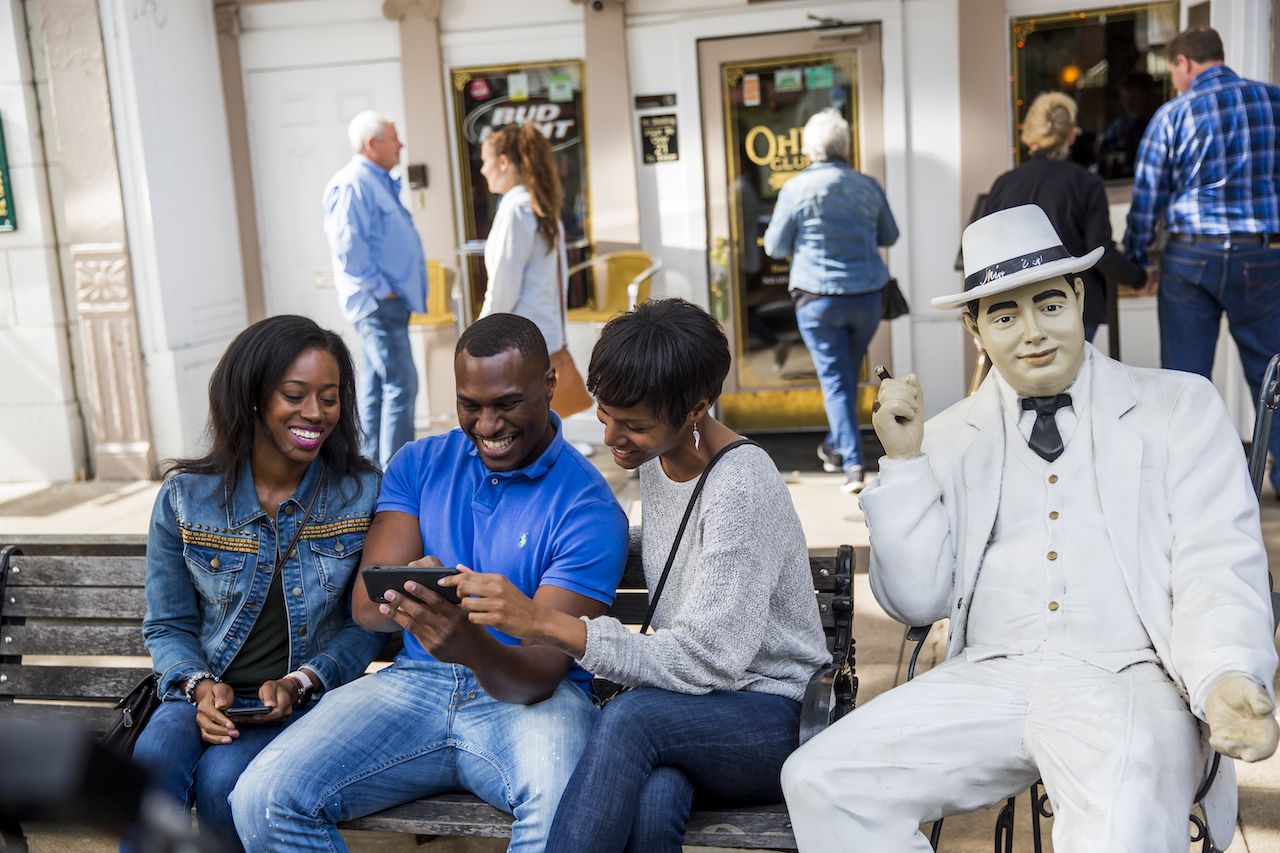
Photo: Visit Hot Springs
The idea of bathing in an ornate, architecturally magnificent bathhouse with dozens of strangers may seem a little odd right now. But 100 years ago, it was the weekend getaway of choice for famous baseball players like Babe Ruth and mobsters like Al Capone.
The 47 naturally flowing thermal hot springs that sit on the southwestern slope of the Ouachita Mountains gave rise to a magnificent strip of bathhouses between 1912 and 1923, which still stand along Central Avenue in Hot Springs, Arkansas. They are part of Hot Springs National Park, the first piece of federally protected land in America when it was designated in 1832. You can actually bathe at two of the bathhouses, Quapaw and Buckstaff, for a much cheaper price than your typical day spa.
Hot Springs is also the only national park with a brewery within the park limits; the Superior Bathhouse Brewery, set in a historic bathhouse but decked out in trendy neon green lights, is also the world’s first brewery to use thermal hot spring water in its beer. Beyond Bathhouse Row, Hot Springs has an array of boutiques, restaurants, and cheesy tourist attractions (wax museums! Magic shows! 4D rides!) within walking distance. Stay at the luxe, yet affordable, Waters Hotel, only a stumble away from the brewery or historic Ohio Club bar and music venue. Soak up your hangover the next morning at The Pancake Shop — and order the works.
Hot Springs has also become a top destination for mountain bikers, too. Less than an hour from town, you can jump on the 39-mile Womble trail, which takes you on a bumpy path along the Ouachita River. Or delve deep into the forest along the Lake Ouachita Vista Trail, which goes deep into old-growth forest and out onto panoramic views of the lake.
21. Gilbert, Arizona
Population: 248,279
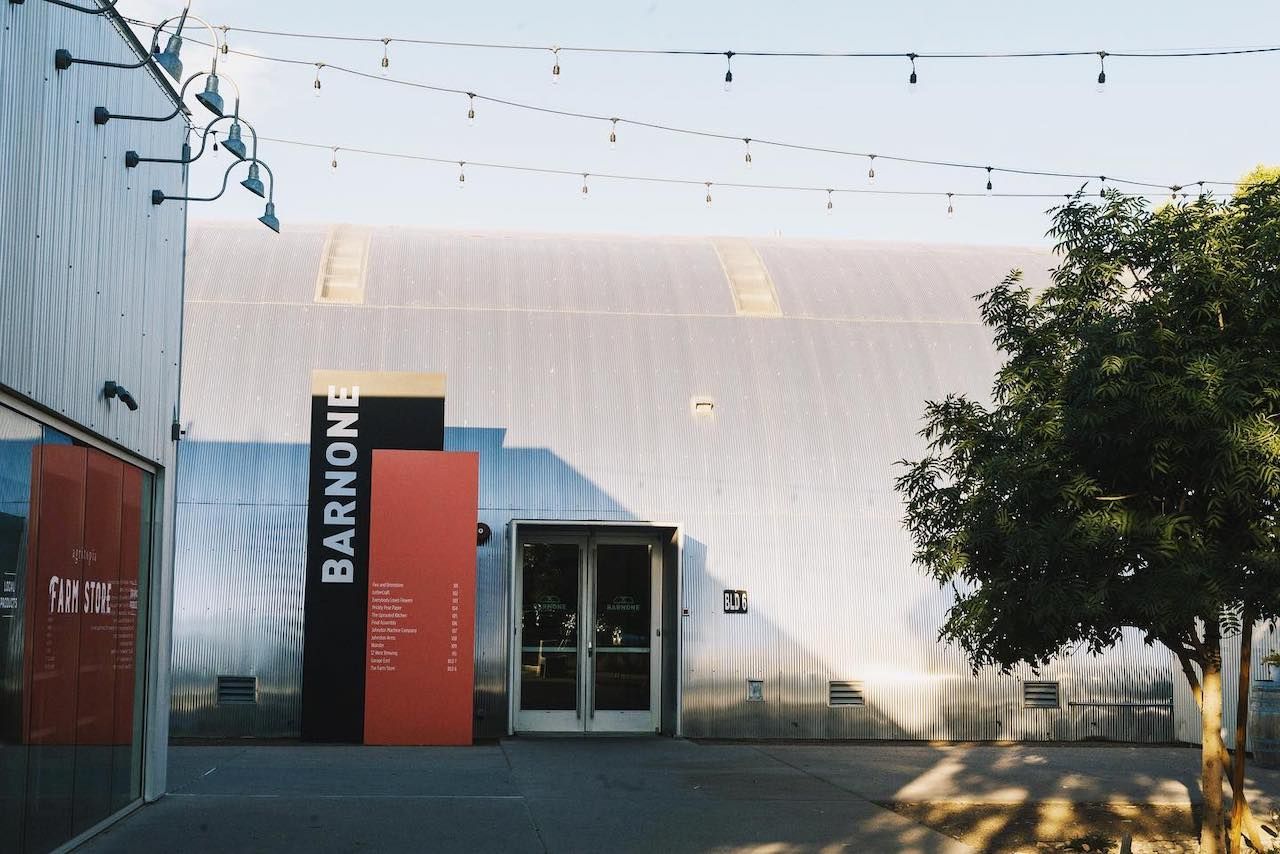
Photo: Barnone AZ/Facebook
Gilbert’s population may not scream “small town” compared to other places on this list, but when you juxtapose it to nearby Phoenix’s population of over 1.6 million, it’s downright cozy.
This Arizona town keeps true to its deeply southwestern roots, evidenced best in the short stretch of the Heritage District downtown. Here, a few blocks of Old West storefronts are bustling with restaurants usually reserved for the city’s glass-and-steel suburbs. Lo-Lo’s Chicken and Waffles and Joe’s Real Barbecue are two of the most indulgent picks here while Liberty Market and Postino East offer lighter fare on a hot desert day. If you’ve got time, catch a show at the Hale Centre Theatre, the longest-running privately owned theater company in North America.
Gilbert still celebrates its agricultural history even in the midst of suburban sprawl. The Agritopia community intersperses new homes with working farms, with restaurants like Joe’s Farm Grill that make the most of their local produce. Explore a giant old hay barn that’s been converted to Barnone, a craftsmen community filled with art and unique goods, along with a brewery, winery and pizzeria — with more vendors coming soon. You can also shop for produce and other cooking goods at a staffless farm shop that operates on the honor code.
The culture might be what gives Gilbert its charm, but the nature is what will make you stay for a while. The Riparian Preserve at Water Ranch is a series of recycled water lakes that draws migratory birds by the thousands. You can also head up to the Gilbert Rotary Centennial Observatory, where the desert sky makes stars shine especially bright, and abundant telescopes make them seem even closer.
22. Jenner, California
Population: 32
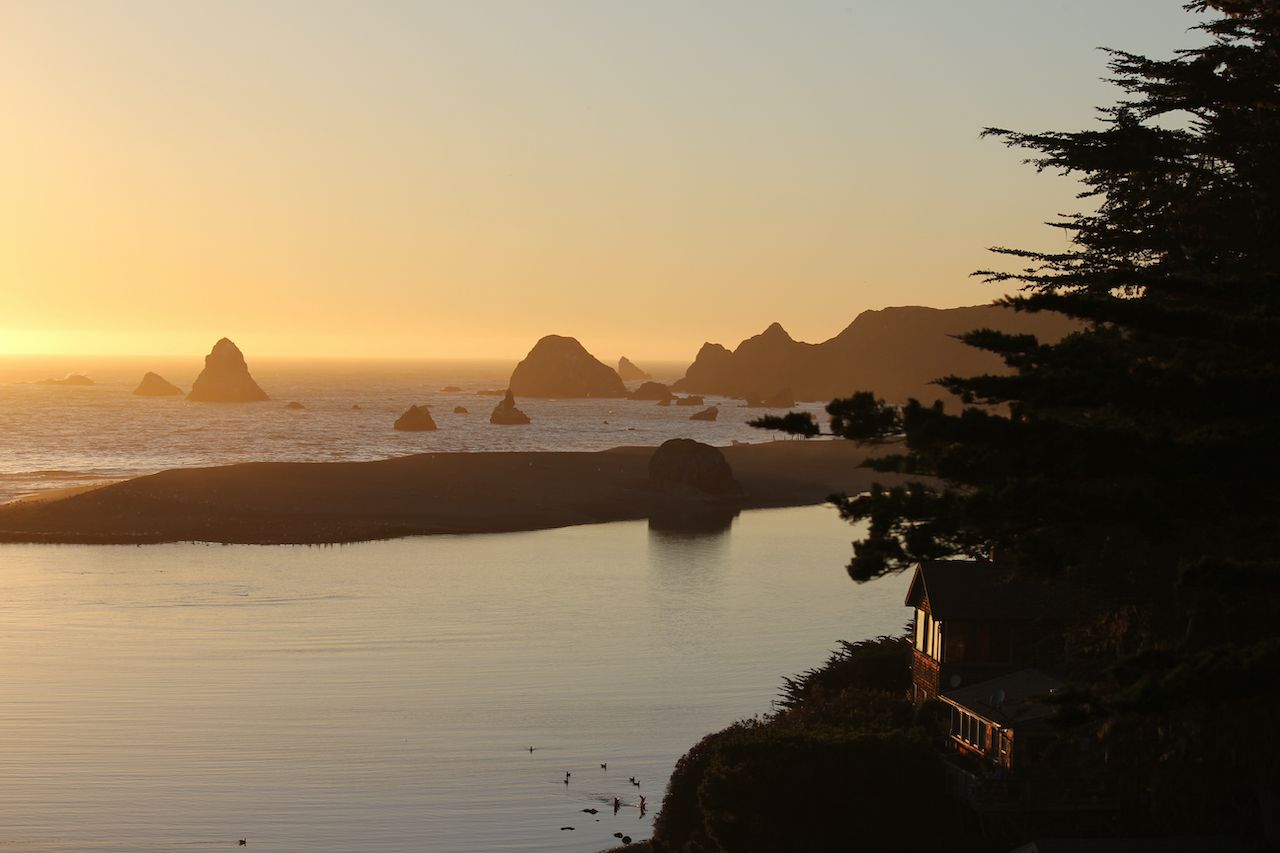
Photo: weriset/Shutterstock
Jenner is Northern California’s wine country done differently. Surrounded on three sides by bigger names in Sonoma County tourism, this barely populated hamlet on the edge of the ocean is sandwiched between the 17-mile Sonoma Coast State Park and redwood-studded Jenner Headlands Preserve. It sits smack where the Russian River meets the Pacific Oceans, creating endless opportunities for outdoor recreation: Think paddling on either body of water, climbing Pole Mountain to scope out the view from the coast’s tallest peak, or lounging alongside seals and gulls at Goat Rock Beach, where there’s also a popular launch point for hang-gliders.
Kayakers can rent gear from WaterTreks EcoTours, as well as arrange tours of the Jenner estuary and beyond. Of Native Kashia Pomo descent, owner Suki Waters is an expert on the region’s history and ecology, and she staffs equally expert guides. Those interested in combining outdoor activity with Indigenous education may also enjoy the Pomo Canyon Trail, a roughly six-mile out-and-back walking route that was once used by Miwok and Pomo traders. Equally popular among shoreline explorers is the 4.5-mile Kortum Trail, which connects Wright’s Beach to Blind Beach within the state park.
Serious hiking aside, visitors can expect a leisurely pace in Jenner. Close proximity to Sonoma County’s 18 renowned AVAs, or American Viticultural Areas, promises easy access to world-class chardonnay and pinot noir. The nearest AVA is Fort-Ross Seaview, with Fort Ross Vineyard located right there in town.
There aren’t many places to stay in Jenner, a fact that contributes to its charm. Campsites are available at the Sonoma Coast State Park, and the Jenner Inn and Fort Ross Lodge are two moderately priced accommodations off California’s famed Highway 1. For something extra special, though, stay at the River’s End Restaurant & Inn. Propped up on bluffs overlooking Jenner’s estuary, its cozy rooms and off-grid cabins boast views that need only compete with those at the restaurant, which serves finer dining than anyone would expect in a town this tiny.
23. Hilo, Hawaii
Population: 46,284
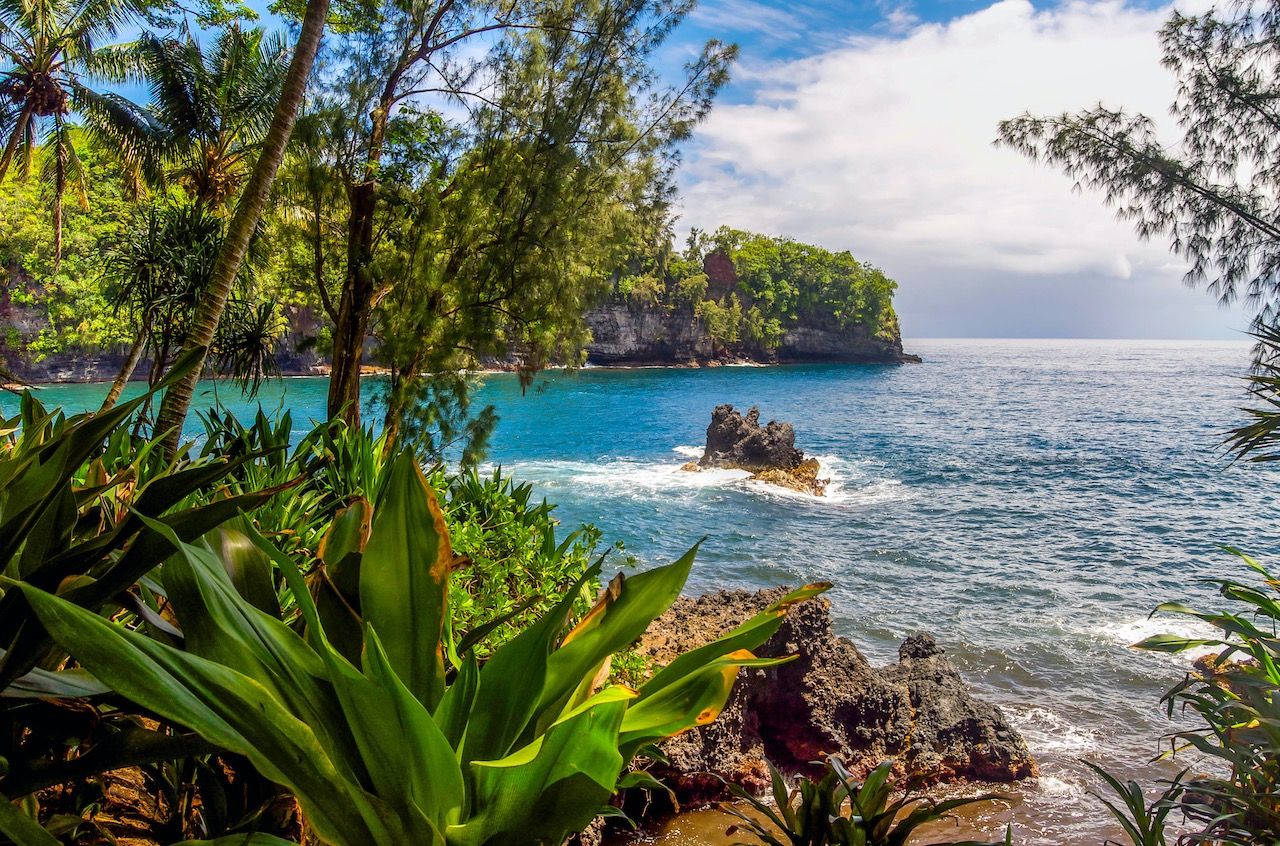
Photo: MH Anderson Photography/Shutterstock
Hilo is not just the rainiest city in Hawaii. It’s the rainiest in the country, with 157 inches of rainfall annually. Why, then, would one hang out in Hilo on their sun-seeking escape to Hawaii? There are plenty of good reasons — starting with the rain itself.
All that wetness supports rich, verdant lushness. Take in the jungly environs just up the coast at the striking ʻAkaka Falls, which plunge 442 feet into a gorge, and at the Hawai’i Tropical Bioreserve & Garden, which has over 2,000 species of plants across 20 acres. In town, the Liliʻuokalani Park houses the largest Japanese gardens outside Japan.
The thought of rain also deters plenty of would-be tourists, making the island of Hawaii’s county seat one of the most genuinely local, laid-back cities in the entire archipelago. You’ll see the multicultural residents reflected at the Hilo Farmers Market, which sells everything from tropical fruits to Portuguese sweet bread to butter mochi. The food scene, naturally, also includes a whole lot of fish. Try poke from the Suisan Fish Market, handrolls from Sakura Sushi, and blackened ahi at Jackie Rey’s. If you prefer to leave the fish in the sea, Vibe Cafe is your vegetarian go-to.
If it’s history you’re interested in, visit the Lyman Museum and its collection of Hawaiian artifacts; the fascinating Pacific Tsunami Museum, which documents the 1946 tsunami that devastated Hilo; or the ʻImiloa Astronomy Center Astronomy Center, inspired by the many international observatories atop the 13,796-foot-high Maunakea just behind Hilo. Maunakea and its sister peak Maunaloa hold the rain clouds firmly in place over Hilo.
But about that Hilo rain. The fact is that on many days it’s actually a gentle sprinkle that soon gives way to sunshine. Even in Hilo, you can relax on the black sand at places like Honoliʻi Beach Park and Richardson Ocean Park. Or you can leave the beaches for the west side of the island to explore all that drizzly Hilo has to offer, including more spectacular waterfalls like Peʻepeʻe and Rainbow Falls.
24. Fairbanks, Alaska
Population: 31,677
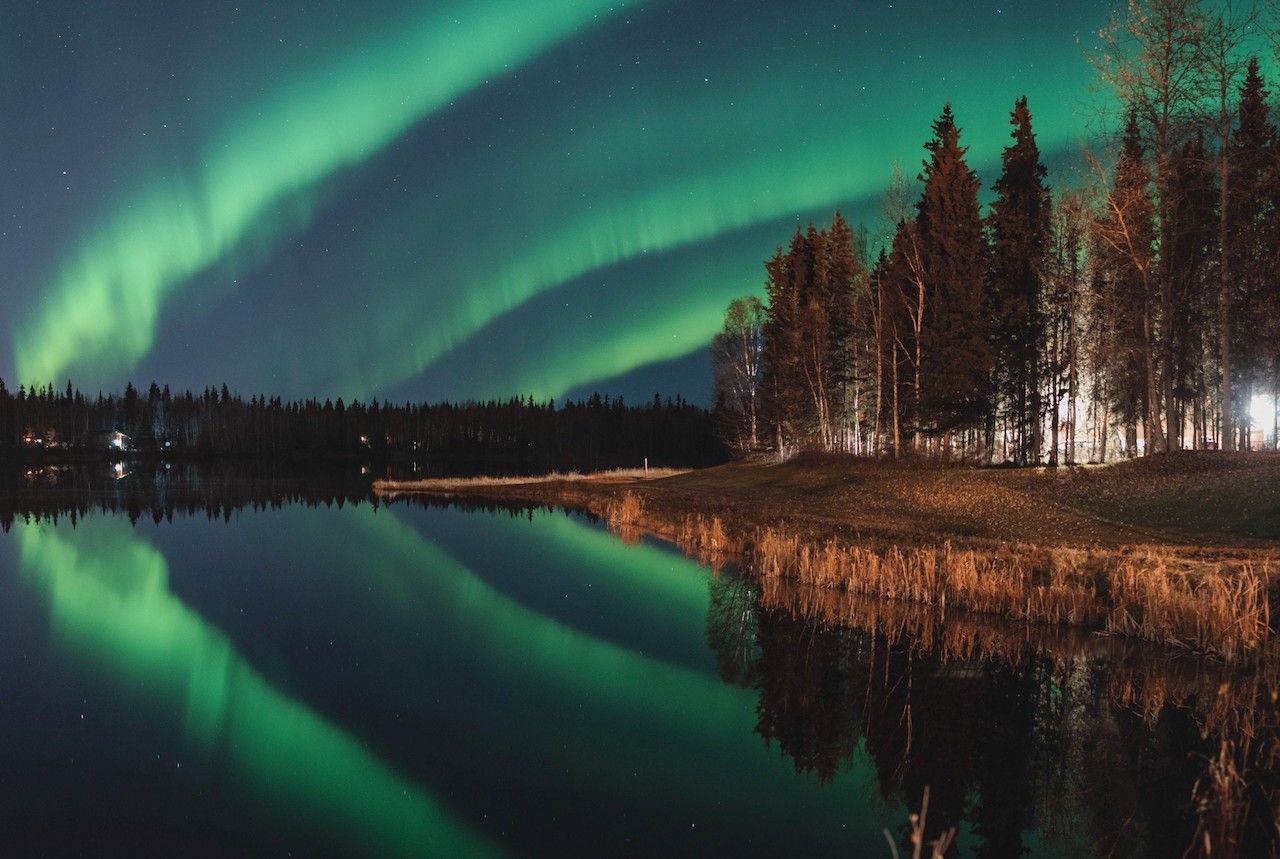
Photo: Andy Witteman / Explore Fairbanks
Sure, Alaska is a bit more comfortable and accessible in the summer, but the state is a winter destination, too, and its northernmost city of Fairbanks comes alive when it’s minus 30 degrees.
Fairbanks might be officially recognized as the coldest city in the US, but it’s also one of the coolest. There are plenty of dog sled tours in the greater Fairbanks area, including Rod’s Alaskan Guide Service in the nearby town of North Pole. In addition to dog sledding, Rod’s also offers multi-day hunting trips, snowmobile tours, and ice-fishing experiences.
Night comes early in Fairbanks — as early as 2:45 PM in December — but that leaves more time for spotting one of the sky’s most spectacular natural phenomena: the northern lights. Aurora Pointe is the place to be for optimal viewing conditions. The farmhouse-like building sits on 280 acres of private land and serves as a gathering place for viewing the aurora away from the city’s light pollution.
You might expect a city in the Alaskan interior to be heavy on salmon and game meat, but ask a resident for their food recommendation and most will insist, “you gotta try the Thai food.” In a town of just over 30,000 people, there are 25 options to choose from. Everyone has their go-to, but Bahn Thai on 3rd Ave and Thai House on 5th Ave are local favorites.
The Alaska Log Cabins on the Pond B&B appeals to those looking for a more rugged experience (be warned: there’s no water or plumbing). For a more luxurious alternative, the Pike’s Waterfront Lodge is right on the Chena River and close to the center of town. It’ll even give you a wake-up call if the aurora appears during the night.
25. Rincón, Puerto Rico
Population: 15,200
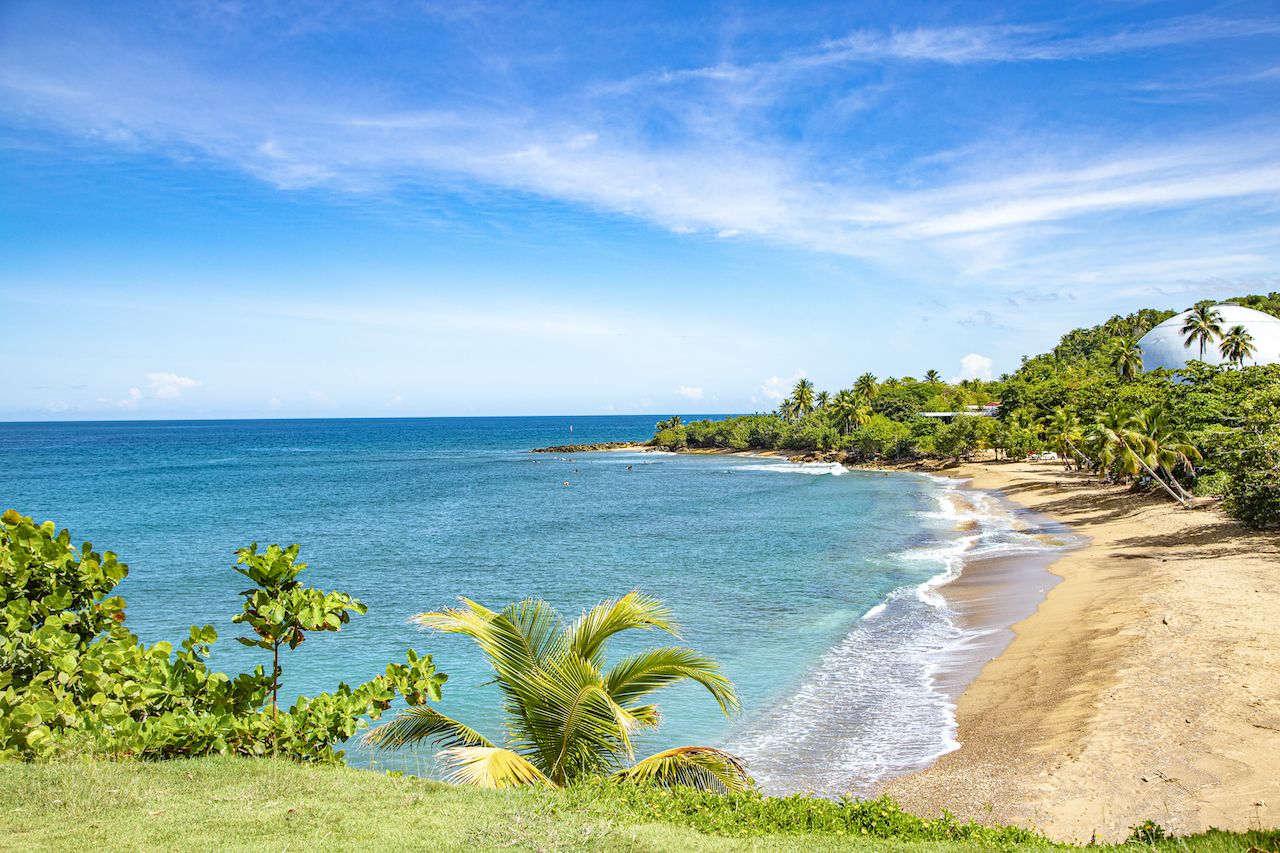
Photo: LibniPhotos/Shutterstock
With COVID-19 largely halting global travel, Puerto Rico is one of the best options for Americans who are craving a more international experience, without the need for a passport. Rather than sticking to the capital city of San Juan, though, head to the west coast to Rincón.
Beachfront Rincón is the island’s surf capital, and it’s especially popular with seasonal ex-pats who make it their home every winter. The town is adjacent to four beaches, so there’s plenty of sun, sand, and surf to go around, even if you hit Rincón on a busy day. In addition to surfing, the beaches are great for swimming, snorkeling, and even whale-watching if you go further out. Taino Divers will take you on guided diving and snorkeling tours to nearby Desecheo Island, and you can rent paddleboards and surfboards at Mar Azul Surf Shop.
Casa Verde, a little patio restaurant steps away from the beach, is a hub of sorts for the snowbird surf community. It’s got live music, cheap rum, next-level chicken tacos, and a buffet of hot sauces to top them with. Down the street, upscale Tamboo is a massive two-story deck overlooking the ocean, serving up fresh salmon, lobster tail, and calamari. If you want to watch the sunset over the water with a cocktail in hand, this is the place to be.
Choosing where to stay in Rincón is a no-brainer. Obviously, you’ll want to be as close as possible to the chicken tacos. Just across the street from the Casa Verde restaurant is a hotel of the same name: the Casa Verde Hotel. Chill in a hammock on the balcony to relax with a view of the ocean.
Editor’s note: Puerto Rico is currently open (with many local restrictions) for all travelers coming from the United States with a negative COVID-19 test or a 14-day quarantine, but only essential travel is currently recommended. Consider booking a trip for later in 2021.
Produced by: Eben Diskin, Aryana Azari, Alex Bresler, and Rulo Luna Ramos
Edited by: Laura Reilly, Director of Editorial